Archive for the ‘Articles of Interest to Collectors’ Category
A Fabulous Well Curated Collection Comes To Auction At Bonhams London On February 20th!
February 10th, 2019
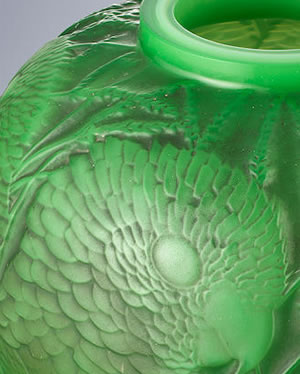
This is one of those few times that we are going to give the ending before we report the story. And the ending is this:
Any serious collector of R. Lalique within a days traveling distance of London by air or train would be nuts* not to go and preview this sale.
Considering the number of rare and hardly ever seen objects, combined with the incredible attention to quality, and the discernment with which this collection was assembled, what we have here is a tour de force of many areas of the collecting field that will astound fans of the great Rene Lalique.
Basically, it’s a graduate level course on what the goods** can look like. And for a serious number of the lots, you can count on one hand how many current collectors have ever had that particular model item in their hand.
If you go to Bonham’s to see and handle all the pieces in this sale, it will likely change your outlook about what constitutes quality. And now to our story.
On February 20th at Bonham’s Knightsbridge in London, over 200 R. Lalique items from a single UK collection will be offered. The collection was assembled over several decades by a low-key, persistent, diligent, and well-informed R. Lalique lover who traveled the world to acquire the various objects on offer.
A numbers breakdown does not do justice to the rarity and quality of the various groups of objects, but here are the approximate counts:
Cire Perdue 1, Vases 47, Paperweights 32***, Car Mascots 40***, Statues/Statuettes 7, Perfume Bottles 9, Boxes 13, Glasses 4, Decanters 8, Seals 24, Bowls 6, Decorations 6, Ashtrays 3.
In addition to the above there are some single lots of particular types including an Invitation, Menu, Pendant, Perfume Burner, Candelabra, and Knife Rests.
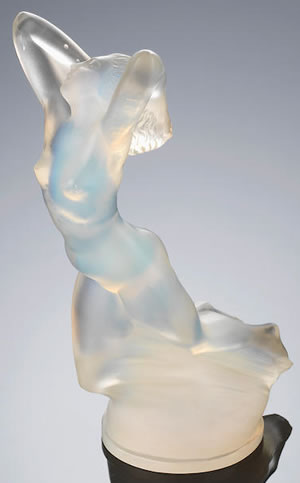 But the story is in the models. Looking at paperweights for example, ignoring crossover mascot/paperweight models, the paperweights comprise all the known commercial examples except a single religious theme 1943 paperweight. That means the incredibly rare Crab, Lobster, and both Sardine Paperweights are offered! But the story is in the models. Looking at paperweights for example, ignoring crossover mascot/paperweight models, the paperweights comprise all the known commercial examples except a single religious theme 1943 paperweight. That means the incredibly rare Crab, Lobster, and both Sardine Paperweights are offered!
The are about 2 dozen seals comprising many extremely rare models including Chamois, Les Sources, and Pigeons. And there are yellow amber examples of both Bressan and Soucis.
The 8 decanters have early and rare models including Aubepines, Masques (with the rare metal stopper), Lezards, and Six Tetes.
Only 4 glasses? How about Quatre Grenouilles, Bague Lezards, and not one but two Mouettes, the seldom seen model made for the Queen of England on a State visit to France in the 1930’s.
The boxes? There are hard to find models like Guirlande de Graines and Louveciennes, but also the impossible to find and totally cool Faune et Figures Box.
The handful of bowls include the rich blue Anges Bowl, the opalescent Cyprins Coupe Refermee, and the opalescent, enameled, and patinated Fleur Bowl.
The car mascots are almost all there. And the quality and rarity will jump out at you. Who do you know with an opalescent Vitesse Car Mascot and an opalescent Chrysis Car Mascot in their collection? How about two different blue Tete De Paon Mascots?
Even the ashtrays have bragging rights to include an alexandrite Alaska and a yellow amber Ecureuil.
Finally, the vases are very heavy in early and hard-to-find, in addition to their extremely high quality. Grande Boule Lierre, Lezards et Bluets, Hirondelles, Inseparables, Camees, Lutteurs, Sirenes et Cabochons, Montargis, Bordure Epines, and Quatre Groupes De Lezards are all offered. And there are some great rare colored vases as well to include the ice blue glass Pigeons Vase and the multi-cased green and opalescent Alicante.
A lot of collectors and dealers toss around the phrase “museum quality” to describe a piece. In this sale, you don’t have to take the seller’s word for it. Here, you have a large number of pieces that were actually exhibited at a museum. And it wasn’t just any museum, it was THE museum. Many of these items have been on loan to the Musee Lalique in France for years, and others were loaned for special exhibition there.
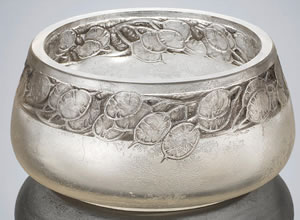 And the provenance on many of the other pieces is notable. We’ll give just 2 examples to make the point. The single Cire Perdue traces to the milestone December 1995 Kagan Sale in New York City. And the great Mouche Seal traces to the December 2005 sale in Paris of items from the estate of Marie Claude Lalique. And the provenance on many of the other pieces is notable. We’ll give just 2 examples to make the point. The single Cire Perdue traces to the milestone December 1995 Kagan Sale in New York City. And the great Mouche Seal traces to the December 2005 sale in Paris of items from the estate of Marie Claude Lalique.
The wrap-up: This collector was not just checking off boxes****, he was filling them in.
There are opportunities here that a typical collector will likely never have again. If you are serious about your R. Lalique, you might plan accordingly.
All the lots can be seen HERE!
* Nuts has many meanings, but here we use it to mean crazy and all the associated words such as mental, bonkers, loco, scatty, meshuga and the like.
** “The goods” in this use is not intended to be the opposite of “the bads”, though these goods are surely so. Here we use it to mean “the stuff” or “the merchandise”.
*** There is some crossover of models for mascots and paperweights.
**** “Checking off boxes” is used here as a metaphor for checking off things on a list by just going thru the motions to complete each task to the most minimum standard.
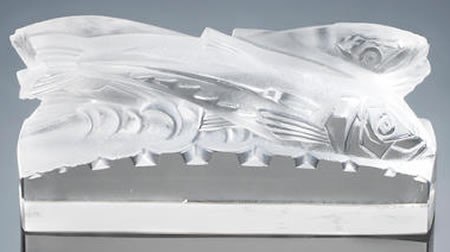
Posted in Articles of Interest to Collectors, R Lalique and Rene Lalique Auction News and Results | No Comments »
Rene Lalique at the Corning Museum: Enchanted By Glass Exhibition
May 20th, 2014
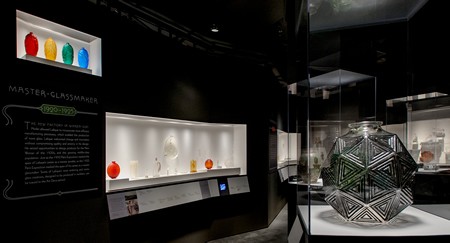
Almost a decade before the birth of Rene Lalique, in a small but burgeoning town a few miles north of Boston, a not quite 40 year old Amory Houghton got in his mind to get in the glass making business. He started with a share in one small local glass company and later acquired other glassmakers. 13 years later, in 1864 Houghton took over the Brooklyn Flint Glass Company in Brooklyn New York. Even with the help of his two sons, the Brooklyn business was financially unstable. And of course the fire was a big problem too. But along came an inspired banker from the small town of Corning New York who convinced the family (naturally money was involved) to move their business to Corning.
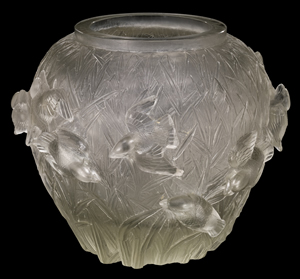 The newly renamed Corning Flint Glass Works was up and operating in 1868, but by 1870 had gone broke. Fortuitously Houghton’s two sons were able to get the business back (sans Houghton Sr.), and succeeded in getting the company on a firmer financial footing, thanks to a small number of products such as colored signal lights for railroads!* The newly renamed Corning Flint Glass Works was up and operating in 1868, but by 1870 had gone broke. Fortuitously Houghton’s two sons were able to get the business back (sans Houghton Sr.), and succeeded in getting the company on a firmer financial footing, thanks to a small number of products such as colored signal lights for railroads!*
Through the years and plenty of ups and downs, the company has had an amazing run through American history. It worked with Edison on his glass for the light bulb, and for Steve Jobs it developed the glass screens for the iPhone. It created the glass for Liquid Crystal Displays (LCDs) and invented Pyrex. It made the mirror for the Mount Palomar observatory and supplied the glass for the primary mirror in the Hubble Space Telescope. And when responding to a 1960’s era request from the British Post Office for a better and more reliable transmission material, it created the optical fiber that has revolutionized communications. And this is just a small sample of the highlights!
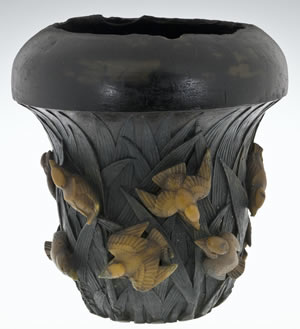 Corning has high tech, high talent, and very low turnover. They are so heavy on innovation and invention, you get the feeling that when a company needs a glass problem solved and approaches Corning, that more often than not a Corning guy in the room says, “We’ve got something on the shelf (from 1, 2, 10, or 20 years ago) we can make work for that.” Corning has high tech, high talent, and very low turnover. They are so heavy on innovation and invention, you get the feeling that when a company needs a glass problem solved and approaches Corning, that more often than not a Corning guy in the room says, “We’ve got something on the shelf (from 1, 2, 10, or 20 years ago) we can make work for that.”
At Corning’s Sullivan Park Research Center, they obtain something in the neighborhood of 25 patents a month as Corning spends around 9% of all revenue for R&D.
But the company is also strong in community and social works. One such undertaking was conceived to help celebrate the company’s 100th anniversary: the establishment of the Corning Museum of Glass (CMoG) in 1951.
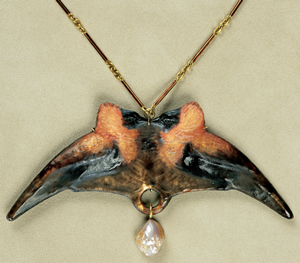 The museum is an independent and not-for-profit organization whose mission it to tell about and keep alive the history and the art of glass. In addition to being an operating museum visited by something like 400,000 people per year, it also holds seminars, classes, demonstrations, workshops, and lectures. It has everything from glassmaking to glass breaking demonstrations, and museum visitors can literally make their own glass as part of their experience at the Corning. On top of all that, the museum is active in both scientific research and publishing on a wide variety of glass related topics. The museum is an independent and not-for-profit organization whose mission it to tell about and keep alive the history and the art of glass. In addition to being an operating museum visited by something like 400,000 people per year, it also holds seminars, classes, demonstrations, workshops, and lectures. It has everything from glassmaking to glass breaking demonstrations, and museum visitors can literally make their own glass as part of their experience at the Corning. On top of all that, the museum is active in both scientific research and publishing on a wide variety of glass related topics.
All in all, the museum is nearing 50,000 different glass objects in its collection that span roughly 35 centuries of glassmaking.
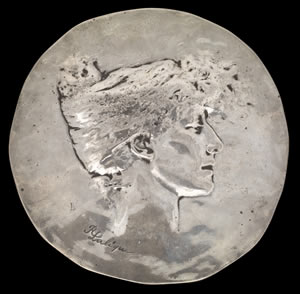 Also part of the museum is the Rakow research library (named after significant benefactors of the museum), the leading research library on glass anywhere in the world. The library has an extensive collection of original period materials on all aspects of glass and glassmaking. Of note is that the collection includes some great original materials related to Rene Lalique (yes, we’re getting to that guy soon:) some of which previously resided right here at World Headquarters! Of course, these are but a small part of the over 2000 documents relating to Lalique’s glass production housed at the Rakow. Also part of the museum is the Rakow research library (named after significant benefactors of the museum), the leading research library on glass anywhere in the world. The library has an extensive collection of original period materials on all aspects of glass and glassmaking. Of note is that the collection includes some great original materials related to Rene Lalique (yes, we’re getting to that guy soon:) some of which previously resided right here at World Headquarters! Of course, these are but a small part of the over 2000 documents relating to Lalique’s glass production housed at the Rakow.
Of the tens of thousand of objects at the Corning, until recently only about 200 were directly related to Rene Lalique. Over half of those were acquired in the early 1980’s, comprising rare models and prototypes (work pieces) which had been kept together by a Rene Lalique et Cie factory supervisor from the period.
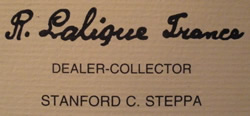 But in 2011, Stanford and Elaine Steppa, New Jersey residents with a longtime involvement in the works of the great Lalique, donated about 400 items to the museum. Most of the items were commercial production pieces, which by their numbers sampled the largest part of the gamut, in time and types, of Lalique’s commercial works. And there were also a few amazing rare unique and nearly unique items as well. But in 2011, Stanford and Elaine Steppa, New Jersey residents with a longtime involvement in the works of the great Lalique, donated about 400 items to the museum. Most of the items were commercial production pieces, which by their numbers sampled the largest part of the gamut, in time and types, of Lalique’s commercial works. And there were also a few amazing rare unique and nearly unique items as well.
So now with around 600 pieces representing everything from the conception to the process to the results, the reference material to back stop it all, and the ability to borrow objects to fill in a random blank or two**; suddenly the story appears in the totality of the materials and objects.
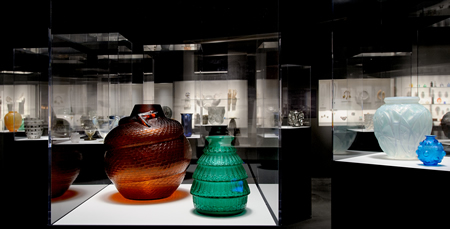
Suddenly, it’s not a good looking glass vase from 1922; it’s the story of the artist and his design development and influences (the swans on the pond or the birds in the trees at the country house). It’s how the glass thing got started (the jewelry, the bottles), how it was industrialized (the models, the patents), how the art was conceived (the drawings) and with what means and what steps (the work pieces) the final object was created. Suddenly, what we call a story, they call an exhibition!
It’s the visual and referential story of Rene Lalique, told one piece at a time through about 200 objects, and amazing period reference material. It’s “Rene Lalique: Enchanted by Glass” at the Corning.
The exhibition is already up and open (as of Saturday May 17th) and will continue through January 4th, 2015.
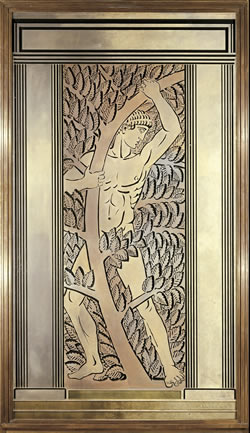 Our takeaway*** from an in-depth interview with the exhibition curator Kelley Jo Elliot**** can be boiled to down to one overriding message. The purpose of the exhibition is to tell the story. From the Cire Perdue Vase, to tell how he did it and how it came to be. From the 1893 exhibition medal, to tell what his goals were, what was important to him, and how he was trying to achieve his aims. From the round green glass invitation medallion, to show his technique and his touch. And from the iconic commercial R. Lalique items such as the Serpent Vase, the Tourbillons Vase, or the Suzanne Statue, to be able to explain in the context of Lalique, his world and his history, how these wonderful art glass pieces were developed. Our takeaway*** from an in-depth interview with the exhibition curator Kelley Jo Elliot**** can be boiled to down to one overriding message. The purpose of the exhibition is to tell the story. From the Cire Perdue Vase, to tell how he did it and how it came to be. From the 1893 exhibition medal, to tell what his goals were, what was important to him, and how he was trying to achieve his aims. From the round green glass invitation medallion, to show his technique and his touch. And from the iconic commercial R. Lalique items such as the Serpent Vase, the Tourbillons Vase, or the Suzanne Statue, to be able to explain in the context of Lalique, his world and his history, how these wonderful art glass pieces were developed.
To help put it all in perspective the exhibition is organized in a couple of ways, including by timeline. So the visitor can see the development of Lalique from unique jewelry all the way to the later big architectural pieces; which would include by the way, the amazing 1932 figural panel from the Wanamaker’s store in Philadelphia.
The museum is located in the Finger Lakes***** region of New York State. It’s 4 or 5 hours drive from NYC, and about the same from Washington D.C.. From Niagara Falls it’s about 3 hours. The closest decent size city is Ithaca, home to Cornell University. And there is small regional airport (Elmira/Corning) that is only about a 15 minute drive (paid shuttle available) to the museum that has flights from Detroit, Philadelphia, Chicago, and Orlando.
The exhibition is included as part of the general museum visitor charge. The museum is open 7 days a week from 9:00 AM to 8:00 PM during the summer, but after Labor Day the closing time moves up to 5:00 PM. Further details can be found at the museum website.
In conjunction with the exhibition, the museum has also published a thoughtful and informative nearly 400 page reference book about Rene Lalique and the Corning, containing hundreds of photos of both commercial and unique pieces, and pictures of a large number of original models. The book is coincidentally titled “Rene Lalique Enchanted by Glass”. Shown here from the book, in addition to a photo of the dust jacket, is a photo of the extremely rare non-commercial Levrier Car Mascot created as a gift for the Prince of Wales in 1929, next to a photo of an original plaster model for that mascot. Who else but the Corning can tell the story like this? The book is out of print, but check the library here on the site or write us directly about getting you one.
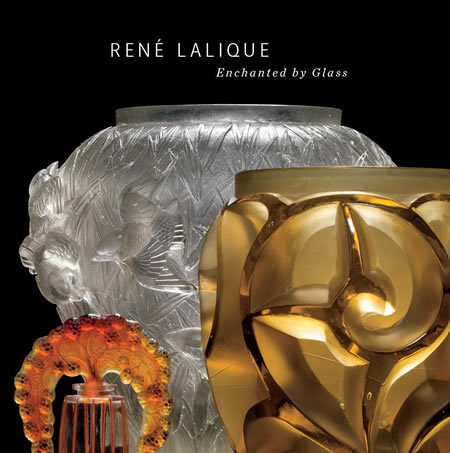
Our final thoughts:
This is not a show where a bunch of brightly colored vases, some valuable jewelry and a few unique objects are tossed together and the exhibitor is just saying, “Hey, look at this, didn’t this guy make cool stuff”. The Corning is fortunately situated with its collection and resources to bring this stuff to life, and to put it in perspective and context historically, educationally, artistically and industrially. It’s a great opportunity for anyone interested in the Rene Lalique and his works. And heck, it’s just an added kicker that the Finger Lakes region of New York is a great place to visit in the summertime!
* Persistence paid off for the Houghton clan. The 1957 Forbes Magazine list of the 76 richest Americans listed both Amory Houghton and Arthur A. Houghton Jr. at between 100 million and 200 million dollars each. In today’s dollars that’s in the billion range (give or take a few hundred million of course).
** Included in the exhibition are 14 unique items (designs, objects, jewelry) on loan from other museums. The lenders are the Calouste Gulbenkian in Lisbon Portugal; the Chazen in Madison Wisconsin; The Walters in Baltimore Maryland, the VMFA in Richmond Virginia; the Smithsonian in Washington D.C.; and the Musée des arts décoratifs in Paris, France. All are linked from our page listing over 80 museums around the world containing the works of Rene Lalique.
*** The “takeaway” is not a quote. It’s more like the gist, the central point, or the main idea as we took it.
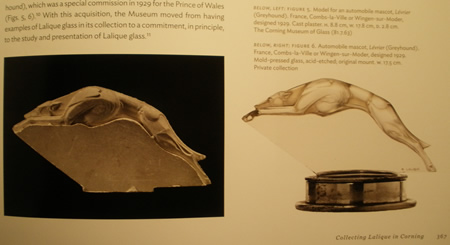
**** Kelley is the Assistant Curator of Modern and Contemporary Glass at the Corning. She has a Fine Art Bachelor’s degree and a Master’s in Decorative Arts History and has worked with a range of museums. She has a strong interest and background in the works of Rene Lalique and in the French artistic glass and jewelry milieu from which he emerged.
***** The Finger Lakes region of New York State is so named because of the pattern of a string of long narrow (and narrowing) lakes which run down from below the New York State Thruway (AKA I-90 or the Thomas E Dewey Thruway) roughly bounded by I-390 in the west and I-81 in the east; kind of in-between but below Rochester and Syracuse. The lakes look like fingers on a map.
Tags: R Lalique Exhibitions and Rene Lalique Exhibitions, Rene Lalique Biography
Posted in Articles of Interest to Collectors, R Lalique and Rene Lalique Auction News and Results, R Lalique Ramblings | 1 Comment »
Myosotis Garniture De Toilette Dresser Set: Background And Appraisal Video
April 20th, 2014
Rene Lalique created several different Garnitures De Toilette (dresser, dressing table, or bathroom sets). The earliest set was created in 1909, with the most prevalent models following in 1919 and 1920 when Fleurettes and Epines were introduced just in time for the roaring 20’s. In the mid 1920’s Perles would make its appearance, and in 1931 Dahlia, Duncan and Enfants would appear in swift succession. Finally during the war years, Helene’s two bottles and one box debuted in 1942.
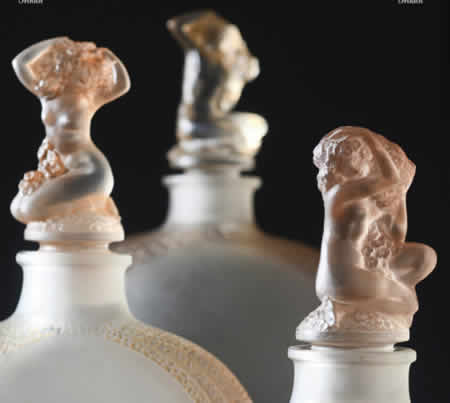
But the most visually stunning, the set with the largest bottles, and the only one of all the Garnitures to feature nude figures would come in 1928! Just three bottles and one covered box. Their name derives from the Greek word for “mouse ear”, the name given to a plant genus with over 200 varieties; so named because of the shape of the leafs which surround the small, usually less than a centimeter wide typically five lobed flowers. The flowering plant exists in Europe and in places as far away as New Zealand and Alaska (where one variety is the state flower).
 The plant is the stuff of legends in Germany, where one legend has it that when God named all the plants, a small genus cried out, Forget-me-not, O Lord! And God replied by naming the plant just that. A bit closer to our time, in the 1400’s in Germany, it was commonly held that if someone wore the flower from this plant, their lovers would not forget them! In 1926 it was adopted as an emblem by the German Freemasons as a message not to forget the needy (Das Vergissmeinnicht), and was likewise adopted by other charitable groups in Germany and elsewhere. It’s also rumored that the Freemasons used it during the Nazi era in Germany in substitution for their typical square and compass symbol as a secret outward means of identification when the Nazis began confiscating Freemason property. The plant is the stuff of legends in Germany, where one legend has it that when God named all the plants, a small genus cried out, Forget-me-not, O Lord! And God replied by naming the plant just that. A bit closer to our time, in the 1400’s in Germany, it was commonly held that if someone wore the flower from this plant, their lovers would not forget them! In 1926 it was adopted as an emblem by the German Freemasons as a message not to forget the needy (Das Vergissmeinnicht), and was likewise adopted by other charitable groups in Germany and elsewhere. It’s also rumored that the Freemasons used it during the Nazi era in Germany in substitution for their typical square and compass symbol as a secret outward means of identification when the Nazis began confiscating Freemason property.
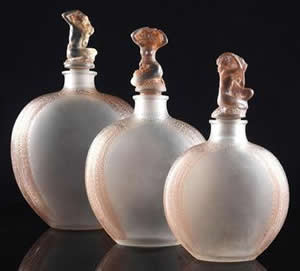 Thoreau (“the mouse ear forget me not…”) and other writers of the 19th and 20th centuries incorporated it into the classic literature of our upbringing. And in 1928, Rene Lalique adopted it as the design motif for the Garniture he named after that same flowering plant: Myosotis. It’s French for “forget-me-not”! Thoreau (“the mouse ear forget me not…”) and other writers of the 19th and 20th centuries incorporated it into the classic literature of our upbringing. And in 1928, Rene Lalique adopted it as the design motif for the Garniture he named after that same flowering plant: Myosotis. It’s French for “forget-me-not”!
The three different sized flask style bottles are each trimmed on the sides in Myosotis, as is the base and cover of the matching box. All four pieces have a different figure on top **; the bottles as the stopper decoration, and the box incorporated into the center of the top of the lid for easy handling.
The bottles range in height from 23 to 29 centimeters, and the box is 16 cm tall.*** All four models are hard to find in good condition today. The reasons for this include the relative high cost of the bottles when originally marketed in the late 20’s and throughout much of the 1930’s, so huge numbers were not sold; the fact that they were introduced just before the depression which had an obvious negative effect on sales all the way up to the start of World War II; and the fact that the large size and narrow flask shape of the bottles made it easy to knock them over, and made it likely that just one fall would do great and irreparable damage.
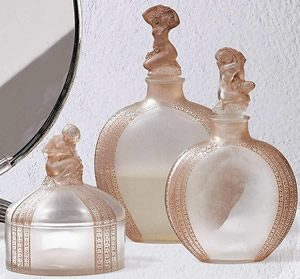 Finally, as with other large nude stoppered pieces such as the vases Douze Figurines Avec Bouchon Figurine (the barrel), and Sirenes Avec Bouchon Figurine (the flask), leaving the stopper in the bottles for long periods of time (decades in many instances) gave rise to glass sickness in the bottles, an unsightly interior cloudiness that is now a common trait of a great percentage of these bottles when they do appear. **** / ***** Finally, as with other large nude stoppered pieces such as the vases Douze Figurines Avec Bouchon Figurine (the barrel), and Sirenes Avec Bouchon Figurine (the flask), leaving the stopper in the bottles for long periods of time (decades in many instances) gave rise to glass sickness in the bottles, an unsightly interior cloudiness that is now a common trait of a great percentage of these bottles when they do appear. **** / *****
Single bottles come up at auction a few times a year somewhere in the world. Complete sets of all four items are very seldom seen, and even sets of just the three bottles are very hard to find as well.
A three piece set with two bottles and the box as shown here did appear at Sotheby’s Paris in November 2009 where it sold for a premium inclusive total of €16,250 for the three pieces, over double the high estimate of €6000 – €8000.
A set of the three bottles sans box also shown here was offered in March of this year at the Drouot in Paris by Coutau-Bégarie with an estimate of €16,000 – €18,000. The auction house chose a close-up of the these three bottles as the cover illustration for their catalogue as shown at the top of this article. The bottles appeared to have glass sickness as seen in the lot photo above, and did not sell.
Finally of course, below is the three bottle set that walked into the U.S. Antiques Roadshow in Corpus Christi Texas. Credit goes to the family cat for the absence of the matching box (didn’t these come with a house pets warning label?), and each surviving bottle in the set had damage, or the sickness that can be seen in the photo, or both. Yet with all those complications, we judge the appraiser came inside the wide range of right with her valuation. The picture is linked to the roadshow page where you can watch the video.
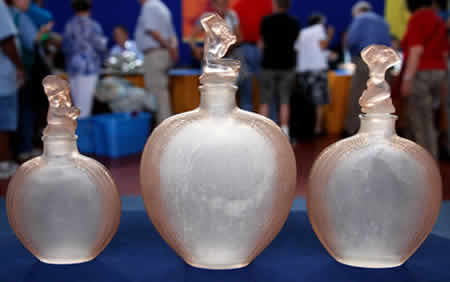
** The stopper design for the largest of the perfume bottles was also used for the Floreal Paperweight mounted on a square black base. This model is extremely rare to find in the authentic R. Lalique version shown in the preceding link. However it has been mightily reproduced in crystal by the modern Cristal Lalique company.
*** Additional information can be found in the Rene Lalique Catalogue here at RLalique.com in the Perfume Bottles category for the bottles, and in the Box category for the box.
**** Glass sickness, or the clouding of the interior of the glass, can usually be removed, but this will have to wait for another article down the road. However we can say for sure now, that the contributing factor of the stopper has nothing to do with its nude (or not) decoration! 🙂
***** You might wonder why the Myosotis bottles are referred to as perfume bottles, flacons, cologne bottles, or Eau De Toilette bottles, while the two Sirenes stoppered bottles mentioned here are called vases. It’s a one-word answer: marketing.
Tags: R Lalique Vases and Rene Lalique Vases, R Lalique Videos and Rene Lalique Videos, Rene Lalique Boxes and R Lalique Covered Boxes, Rene Lalique Perfume Bottles - R Lalique Perfumes
Posted in Articles of Interest to Collectors, R Lalique and Rene Lalique History | No Comments »
Rene Lalique Calypso And Ondines Light Fixtures – The Mailbag
January 30th, 2014
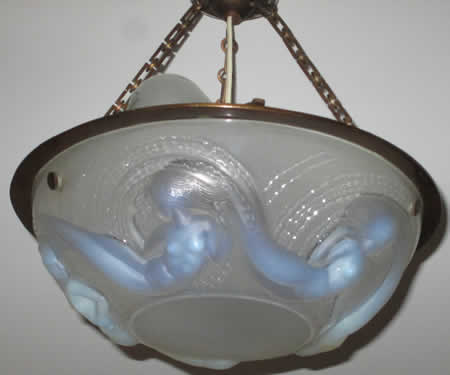
Ok Ok, there never was a Rene Lalique Calypso Light Fixture back in the day. But somehow they keep popping up, and we’ve had a few questions about them in our overloaded mailbag from time to time. So we figured with the latest inquiry, to clear it up not just for our current readers, but for anyone down the road that might be looking up at 5 or 6 mythical nude siren figures swirling around an overhead opalescent glass bowl shaped light fixture sporting an R. Lalique signature!
The inquiry:
I would be grateful for any help you can give me in authenticating a chandelier I own.
It would appear to be an Ondines Chandelier by R Lalique but I cannot find any reference on your or other websites to chandeliers appearing with the Ondines design.
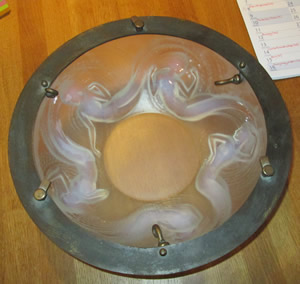 I believe that the item has been in my family for at least 60 years. The bowl itself is 9 cm high and 30 cm diameter (approximately). The faint R Lalique stamp appears in the centre of the base of the bowl. I believe that the item has been in my family for at least 60 years. The bowl itself is 9 cm high and 30 cm diameter (approximately). The faint R Lalique stamp appears in the centre of the base of the bowl.
I attach three photos including one showing the Lalique stamp.
I am hoping that you can let me know whether the chandelier was made as such, is a bowl later converted into a chandelier, and in either case whether it is a genuine Lalique piece.
I look forward to hearing from you.
Regards
Mr. X
The reply:
Hi Mr. X. Thanks for visiting the website and for contacting us.
The bowl is not Ondines (6 sirens), but Calypso (5 sirens).
https://rlalique.com/rene-lalique-calypso-bowl
This appears (we don’t authenticate items that are not fully visible, and with the hardware on, your piece it is in that category) to be a converted bowl, with all the hardware added. Forgetting all the facts, think about Rene Lalique …. the undecorated flat bottom is the giveaway…. it wouldn’t** be like that for something made and sold by him as an overhead fixture …. it just doesn’t go over.
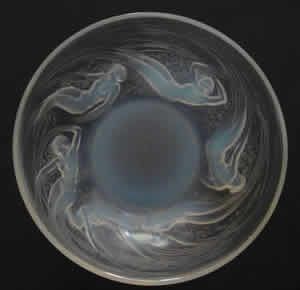 Because Calypso is bigger (Ondines bowl is 8 inches), it is more often seen converted to a hanging or ceiling fixture. Because Calypso is bigger (Ondines bowl is 8 inches), it is more often seen converted to a hanging or ceiling fixture.
This is not the first of these we’ve seen of course:
https://rlalique.com/rene-lalique-calypso-chandelier
And see this very similar 2-siren model, which was sold as a fixture for the difference in how it would look from below as an original light fixture design by R. Lalique:
https://rlalique.com/rene-lalique-deux-sirenes-chandelier
Best Regards,
KOL
We could have skipped a lot of typing by just observing that it appears the sirens are still busy luring the unwary onto the rocks! **
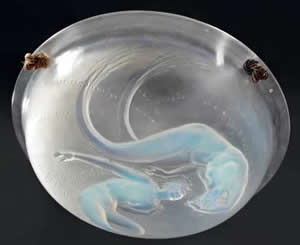 And we didn’t get into the number of hanging cords with the questioner, but it appears from the photos that there are only three, and four would be much more typical for these hanging bowl fixtures from Rene Lalique. And we didn’t get into the number of hanging cords with the questioner, but it appears from the photos that there are only three, and four would be much more typical for these hanging bowl fixtures from Rene Lalique.
Finally, on a more esoteric level, there is the whole question of altered items typically being deemed drastically less desirable and less valuable (or nearly valueless in many cases) by collectors when Lalique himself never would have put a curse on pieces put to good alternate uses. Usable art glass brought into the homes of everyday people; Lalique himself spoke about it. Heck, he invented it.
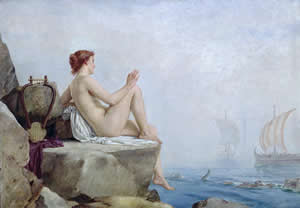 And about alterations, he drilled holes in many bowls (but not Calypso or Ondines) to attach hanging cords, and marketed them as light shades. He cut bowls in halves and quarters and called them appliques. He affixed seals to small dishes and called them ashtrays. He sold car mascots as paperweights, and re-used parts from some pieces to make others. He even drilled holes into the sides of vases for running electric cords to convert them to lamps. Heaven Forfend! And about alterations, he drilled holes in many bowls (but not Calypso or Ondines) to attach hanging cords, and marketed them as light shades. He cut bowls in halves and quarters and called them appliques. He affixed seals to small dishes and called them ashtrays. He sold car mascots as paperweights, and re-used parts from some pieces to make others. He even drilled holes into the sides of vases for running electric cords to convert them to lamps. Heaven Forfend!
Just thinking out loud ……. well actually, just typing silently :).
** Of course a plain bottom did not prevent the marketing of Madagascar as a light fixture. But this is not really a direct comparison as the bottom of Madagascar though big, is crudely ancient (not in a bad way) and not flat.
*** In Greek mythology, the sirens lured nearby sailors to wreck their ships on the rocks by attracting them with wondrous sounds. Just above is The Siren, a wonderful painting by the 19th century British artist Edward Armitage. Even today, the phrase “siren song” is used to describe something that sounds great but is not going to end well.
Tags: Rene Lalique Bowls and R Lalique Bowls, Rene Lalique Lighting: R Lalique Lighting Fixtures
Posted in Articles of Interest to Collectors, R Lalique and Rene Lalique Fakes-Copies-Frauds, The Mailbag | No Comments »
A Rene Lalique Tristan Vase In Blue Glass Sells For $125,000 At Sotheby’s New York
January 19th, 2014
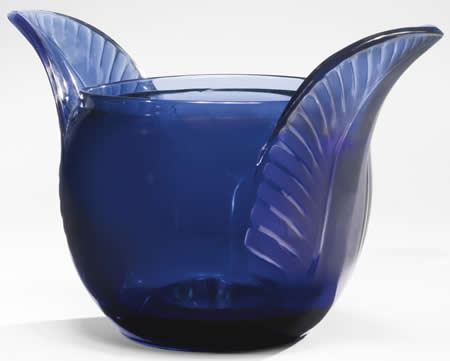
If you always wondered what King Arthur and the Knights of the Round Table, 16th Century Portuguese explorers, the movie “Legends of the Fall”, U.S. baby naming preferences, and Rene Lalique have in common; well we have the answer right here!
 In Arthurian legend, Tristan (as shown here in an Arthur James Draper depiction) is the 12th century** Cornish Knight of the Round Table having a scandalous relationship with Iseult, the wife of the King. Incidentally, this tale of complicated involvement was kept alive in story form in France by hundreds of poets over the following centuries. In Arthurian legend, Tristan (as shown here in an Arthur James Draper depiction) is the 12th century** Cornish Knight of the Round Table having a scandalous relationship with Iseult, the wife of the King. Incidentally, this tale of complicated involvement was kept alive in story form in France by hundreds of poets over the following centuries.
A few hundred years later, the Portuguese explorer Tristao da Cunha stumbled upon what is now the most remote inhabited archipelago in the world, around 1750 miles south of South Africa. He named the main island and the island group after himself. Go figure.*** The islands have a bit of a colorful history being used as a weather station and U-Boat monitoring facility during World War II; being visited by the Duke of Edinburgh in 1957 (with the pictured main town Edinburgh of the Seven Seas then named after him); and being dang close to a late 1950’s U.S. Atomic Bomb test!
 But before the 1900’s, when the Brits got a hold of the islands (formerly annexing them in 1816 just after the first permanent settler from of all places Salem Massachusetts landed in 1810), they dissed Tristao and changed the name to Tristan da Cunha, a name that has been shortened colloquially to Tristan. Note that the Queen of England still reigns over Tristan and it’s 250 or so inhabitants. But before the 1900’s, when the Brits got a hold of the islands (formerly annexing them in 1816 just after the first permanent settler from of all places Salem Massachusetts landed in 1810), they dissed Tristao and changed the name to Tristan da Cunha, a name that has been shortened colloquially to Tristan. Note that the Queen of England still reigns over Tristan and it’s 250 or so inhabitants.
In 1928, Rene Lalique, a man not unfamiliar with complicated involvements, introduced his vase model no. 1013. The vase was a heavy plain round container, with a pair of opposing large upward pointing and outward curving leafs. He named the vase Tristan.
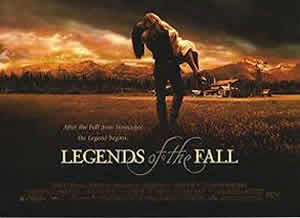 A little closer to our own time, after the great movie “Legends of the Fall” was released in 1994, Tristan, the name of the character in the movie played by Brad Pitt, became (and remains to this day) one of the top 100 baby boy names in the United States! Sadly, the author of Legends Of The Fall, Jim Harrison, passed away in Patagonia Arizona March 26th, 2016, not far from World Headquarters. He had moved from rural Michigan to Montana (the setting for the story), and Arizona. In each place he wrote in solitude, surrounded by natural beauty. And while he stood on the shoulders of Thoreau, his writing was uniquely his own. He was regarded by many as the greatest living American fiction writer. A little closer to our own time, after the great movie “Legends of the Fall” was released in 1994, Tristan, the name of the character in the movie played by Brad Pitt, became (and remains to this day) one of the top 100 baby boy names in the United States! Sadly, the author of Legends Of The Fall, Jim Harrison, passed away in Patagonia Arizona March 26th, 2016, not far from World Headquarters. He had moved from rural Michigan to Montana (the setting for the story), and Arizona. In each place he wrote in solitude, surrounded by natural beauty. And while he stood on the shoulders of Thoreau, his writing was uniquely his own. He was regarded by many as the greatest living American fiction writer.
And in our own time, and perhaps more important to most readers than all the preceding (unless of course you are a relative of Alice’s Adventures In Wonderland author Charles Dodgson, better known as Lewis Carroll, whose younger brother was a missionary and schoolteacher on Tristan); on December 18th at the Sotheby’s salerooms in New York City, a cobalt blue Rene Lalique Tristan Vase appeared as Lot No. 122. The 8 inch by 13 inch vase, with its unique form and rare coloring was estimated at $45,000 to $60,000. But by the time the hammer came down it had more than doubled the high end of that estimate with a final sales price including commissions of $125,000!
 That price makes the blue Tristan Vase total, one of the five highest auction sale prices that we know of having ever been recorded for a colored glass R. Lalique commercial vase, putting it in close company with the red Hirondelles Vase, the cased yellow Oranges Vase, and the blue Poissons Vase. That price makes the blue Tristan Vase total, one of the five highest auction sale prices that we know of having ever been recorded for a colored glass R. Lalique commercial vase, putting it in close company with the red Hirondelles Vase, the cased yellow Oranges Vase, and the blue Poissons Vase.
Another world record auction price for an R. Lalique Vase. It’s like déjà vu all over again.****
** 12th Century: or 11th or 13th, you can never be too approximate with legends.
*** “Go figure” is an American slang with a few related uses, including the one here to emphasize and ridicule that the obvious or expected had happened.
**** “It’s like déjà vu all over again.” is one of many famous expressions from the New York Yankees great Yogi Berra. He had a well-deserved reputation for entertaining phrases including “It ain’t over ’til it’s over.” When asked about his reported ability to twist a phrase, he replied “I really didn’t say everything I said.”
Tags: R Lalique Rene Lalique Auctions News and Results, R Lalique Vases and Rene Lalique Vases
Posted in Articles of Interest to Collectors, R Lalique and Rene Lalique Auction News and Results | No Comments »
Rene Lalique Replacement Parts: R. Lalique Boxes, Decanters and Perfume Bottles
May 16th, 2013
The bottom of the great and early R. Lalique Box was knocked off the counter and is gone forever. The R. Lalique Decanter bottom is krizzled, glass sick, or just cracked. The stopper to that great R. Lalique Perfume Bottle was dropped on the tile floor and is no more (that rhyme was not on-purpose). Many a collector, owner, or dealer has faced just these circumstances and many of these tales of woe find their way to the inbox here at World Headquarters!
One email on this subject, a non-woeful one at that, caused us to reflect a bit on these common occurrences and we thought we’d write a little about the whole subject of replaced parts because it comes up surprisingly often.
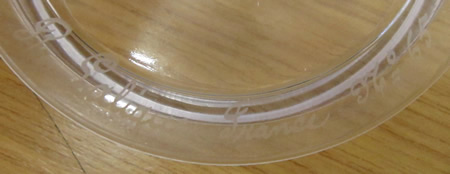
For starters we want to limit what we are talking about. We are only talking about pieces that have common parts originally made just that way by Rene Lalique Et Cie prior to the end of World War II in France.
So modern reproduced parts are not within the scope, including anything made by the modern Lalique company in crystal after the death of Rene Lalique. Also, a part made new after the war to look like an authentic part is also not within the scope (see the Faked Cluny or Senlis Vase story).
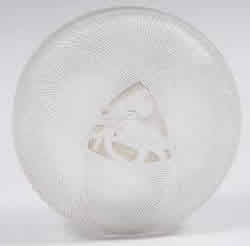 And this includes parts made from actual R. Lalique glass. So for example, if a dealer gets a glass guy to make a new stopper out of the thick base of a broken vase; to literally hand carve the thing from authentic Rene Lalique glass to the point where virtually no one would know the difference, this is not what this article is about. And this includes parts made from actual R. Lalique glass. So for example, if a dealer gets a glass guy to make a new stopper out of the thick base of a broken vase; to literally hand carve the thing from authentic Rene Lalique glass to the point where virtually no one would know the difference, this is not what this article is about.
And of course, the instance where a dealer takes the entire bottom off of a broken vase, and has it virtually seamlessly installed (better to say “unseemly” installed?) to replace the cracked bottom on another vase is definitely not for this discussion either.
We singled out boxes, decanters and perfume bottles because virtually every one of these items has at least two parts, and each of those parts was made in some volume. And that volume in many instances does not even have to be for the same model piece. For example many decanters share the same bottom; the same “blank”, and the only difference is the stopper (ignoring the addition of a signature, model number, and the scratched matching numbers on the stopper stem and decanter bottom to keep the pieces together during the finishing process). Ignoring the manufacturing differences in the mold blown decanter bottoms and the hand fitting and polishing of the stoppers, the decanter bottoms are meant to be identical in maybe a dozen or so original R. Lalique stemware sets. The bottom to a Colmar decanter is the same model as the bottom to a Obernai Decanter.
So in the spirit of the great American inventor Eli Whitney ***, the parts would be, in a perfect world, interchangeable. So if you break your decanter bottom, you can patiently wait on Ebay for the bottom to your model to come up. Or if you happen to have a model that has the bottom shared by others, for any one of them to come up. Or you can cruise the Paris flea market. Or you can contact RLalique.com and tell us about your “Want”. Of course, we don’t live in a perfect world but it’s close enough that many seemingly hopeless situations can be addressed.
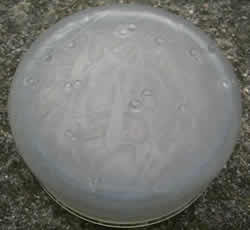 Sometimes a complete decanter, perfume bottle, or box may come up for sale, but because of the model, or damage to one of the pieces, or just luck of timing, it may go for a low enough price that it pays to buy the whole thing just to get the undamaged part you want (and hope it fits of course). Sometimes a complete decanter, perfume bottle, or box may come up for sale, but because of the model, or damage to one of the pieces, or just luck of timing, it may go for a low enough price that it pays to buy the whole thing just to get the undamaged part you want (and hope it fits of course).
Well, we thought about all of this when the following email arrived which references the 1st photo above. And note that the names have been removed to protect the innocent of course:):
Dear Info@rlalique,
I have a query that needs your help!
My name is XXX and I work for a YYY based auction house in ZZZ. We have recently had a group of Lalique items consigned to us from a vendor who was left them. Amongst them is a Genevieve powder box. On your website the box is listed as Model Number 57, the one we have has an etched mark but is numbered 65. I cannot find any record of a model 65, can you help me? I have attached a photo of the mark if that helps. Kind regards,
XXX
The good news is the auction house is on the ball. Let’s face it. You got ghosts, where do you go? Actually, does Ghostbusters even have a website? Ok, let’s just move on.
So right away you know the auction house wants to get it right because they got the goods and went straight to RLalique.com and the new Rene Lalique Catalogue here at World Headquarters to make the identification! And they were on the ball enough to know because of the markings on the base (shown in the photo of the signature near the top of this article) that something was amiss. The catalogue says it’s box number 57, the base says it’s number 65. Hmmmm.
Our reply (again with identifying stuff blanked out and some minor grammar fixes to make us sound like we were paying attention in 5th grade English the day they mentioned dangling participle and other unknowable grammar stuff :):
Hi XXX. Thanks for contacting us. We are familiar with your auction house as we list R. Lalique items that come up in your sales in our Worldwide Auction section of the site. The last time was QQQQ.
About your question, it’s not unusual for the bottoms of boxes to be switched as many boxes use a common bottom. This can happen where the same owner has several boxes of the same size that use the same common box bottom. Or if the bottom is broken or lost and a dealer or an owner obtains a good bottom that appears on Ebay or elsewhere (Paris flea market) that has had the top to it break or disappear. Even today, since most of the blank common box bottoms have a signature on them, they can be identified as R. Lalique. And a couple of times a year a blank box bottom appears on Ebay for sale.
With R. Lalique, the same thing can occur with say some of the tableware set decanters, where the same blank was used for the bottom (the container) on maybe a dozen models, and the only difference is the stopper. Bottoms to these decanters do show up on the market from time to time, just like box bottoms, and if your decanter bottom gets glass sickness or gets broken, if you have a model that shares a common bottom, you can find a replacement that may or may not have a different model number written on it. Of course the stopper fitting properly is a bit more problematic with the mold blown decanter bottoms and hand fitted stoppers, than for the much more standard press mold boxes.
Box No. 65 is a box called Gui and it’s a 10 centimeter box just like the Genevieve. These two models actually appear next to each other in the 1932 Catalogue. So what you have is the bottom to a Gui box under a Genevieve box top. The bottoms would be identical other than the signature with that number (assuming the bottom you have is clear glass and not opalescent glass), and for most people it would be a distinction without a difference.
https://rlalique.com/rene-lalique-gui-box (where you can see part of the bottom in one of the photos)
There is also a slim chance that the mistake was made at the factory as very, extremely rarely, we see a mis-numbered piece. But we’d bet on it being a switch or replacement as described above.
And it might pay to talk to the consignor (assuming it’s a private and not a dealer) on the chance the Gui box is with a different family member or can be located and the original mates restored.
If you have any further questions, let us know.
KOL
Of course, now that we let the “yes there are repair guys that can make a stopper from a chunk of glass” fact out of the bag, it goes without saying that a good glass guy could clean up the inscribed number on the bottom of a box :).
And of course, even with mold pressed smaller pieces, due to the manufacturing techniques of the day, as well as possible later polishing to either or both the top and bottom, there might be some minor “fitting” involved even when switching what should be the same basic bases among boxes. A hair taller, a hair thicker would not be out of the question. In that regards consider the following:
We contacted two different owners of incredible box collections. Each checked their Genevieve Box and Gui Box bottoms for us and sent us photos and descriptions. In both photos the Genevieve Box bottom is on the left and the Gui Box bottom is on the right.
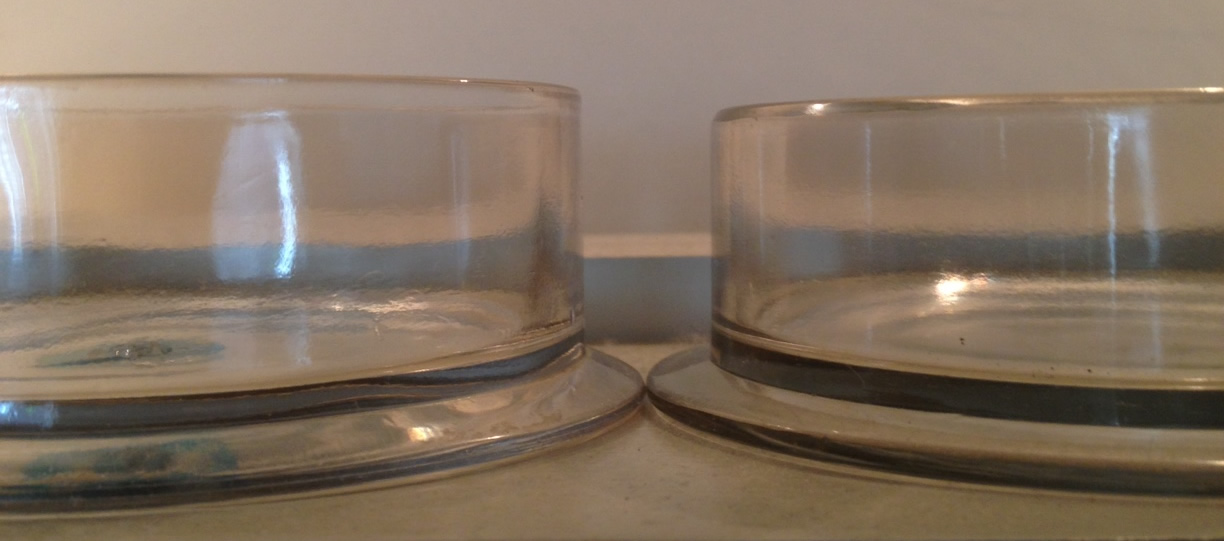
Collector 1 sent a photo (just above) showing their Gui box bottom to be shorter than the Genevieve bottom. And noted that the Gui top could not fit properly on the Genevieve bottom unless that bottom was lowered (polished down) slightly.
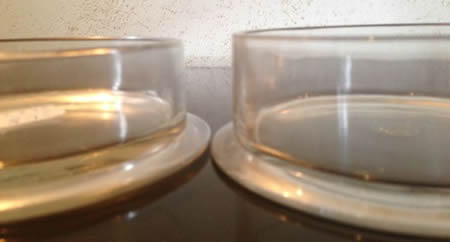
Collector 2 sent a photo (just above) showing their Gui box bottom to be taller than his Genevieve bottom! And this collector noted that the Genevieve box top would not fit over the Gui box bottom unless the Gui bottom was lowered slightly! This is exactly the reverse of Collector 1.
So, either it’s fit and finish at the factory owing to less than exact sizes coming out of the molds at the factory, or later polishing to either the top and/or bottom, or both. But again, the fact remains; the bottoms are basically interchangeable, possibly with some minor glass guy adjusting.
Here is another example of a different replacement part “Want” that was satisfied just last month:
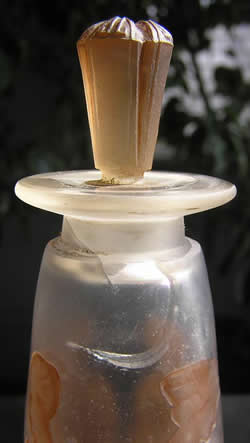 The request (again, ID’s hidden and minor grammar corrections to make everyone look better): The request (again, ID’s hidden and minor grammar corrections to make everyone look better):
good day to you from AAA, I am looking for the glass stopper for the COTYS AMBRE ANTIQUE perfume bottle. If anyone can help, many thanks BBB
Our reply:
Hi BBB.
Thanks for visiting the website and for contacting us.
BBB, the following Ebay listing appeared yesterday. The bottle is cracked and may sell very cheaply. The listing does not mention any issues with the stopper, though we’d suggest you confirm that with the seller before bidding. And also note that there is no assurance the stopper from one bottle will fit another. But it may be worth a chance.
RENE-LALIQUE-FLACON-FOR-COTY-AMBER-ANTIQUE-CIRCA-1910 Item: 121087944635.
Good luck if you decide to pursue it, and if you don’t get it, let us know and we’ll post your stopper in the wanted section.
Best Regards,
KOL
Their reply:
KOL, thank you so much for spotting this.I will give it a try and let you know. This is the first sniff of a stopper that I have had for a year, so fingers crossed. Best Regards BBB
Our further reply:
Hi BBB. We listed another one of these today that’s at a small house in PA. The pic looks rough, but the stopper may be in good order and it seems a reasonable chance for a bargain if it is.
KOL
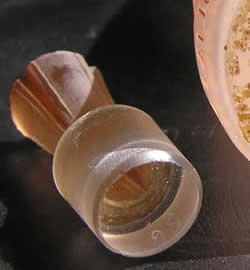 And the last we heard: And the last we heard:
Hi KOL, with the help from an American buddy here I managed to get that bottle. It has not arrived in the AAA yet but so pleased I have it. All thanks to you and your diligence, so again many thanks for your help. ( think I’ll look for a nice Perruches bowl next. ) BBB
And of course the big question, is there anything wrong here in replacing a missing or broken part with a supposedly or nearly identical original R. Lalique part? Feel free to weigh in with your thoughts in the comments.
*** Eli Whitney was born in 1765 in Massachusetts. He invented the Cotton Gin in 1793. It’s an easily made machine that removes seeds from cotton much faster than the previous hand removal method of picking them out one by one. He later manufactured weapons such as muskets and was an aggressive advocate of manufacturing using interchangeable parts. Whitney had a major impact on the entire United States in the antebellum period. Counterintuitively, though the Cotton Gin was a labor saving device, it made slavery a stronger institution in the South and enriched the South by making previously unprofitable cotton types and fields profitable by lowering the cost of production. Cotton production skyrocketed after the introduction of the cotton gin, slave labor became highly profitable, and a declining slave industry was re-invigorated. In the 17 years after the appearance of the Cotton Gin, U.S. cotton exports grew by nearly 200 times! Not 200 percent, but 200 times! As a result, in the decades before the Civil War, cotton accounted for over one-half of all U.S. exports.
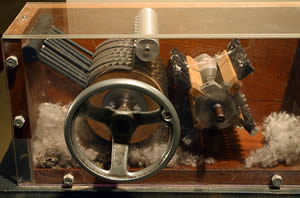 On the other hand, while the South was engaged in a vast agricultural based commercial and wealth expansion because of the cotton gin, his push to manufacture with interchangeable parts strengthened the North’s existing industrial advantage over the South, and thereby contributed significantly to the North’s victory in the Civil War. On the other hand, while the South was engaged in a vast agricultural based commercial and wealth expansion because of the cotton gin, his push to manufacture with interchangeable parts strengthened the North’s existing industrial advantage over the South, and thereby contributed significantly to the North’s victory in the Civil War.
Tags: R Lalique Decanters and Rene Lalique Decanters, Rene Lalique Boxes and R Lalique Covered Boxes, Rene Lalique Perfume Bottles - R Lalique Perfumes
Posted in Articles of Interest to Collectors, R Lalique Ramblings | No Comments »
Lalique Dealer pinkcupcakes-uk Selling Rene Lalique Glass On Ebay: R. Lalique Buyers Beware
February 23rd, 2013
It’s been a while since we have been motivated to write about an Ebay seller of the works of Rene Lalique. The last time was to bring the practices of the Ebay screen name Dounial, aka Naim Bouchareb, dba Renaissance Antiques of Iowa to your attention.
But we write today to discuss three offerings on Ebay from pinkcupcakes-uk (we shorten that up to “Pinky” for brevity), a Norwich UK regular dealer in R.Lalique items.
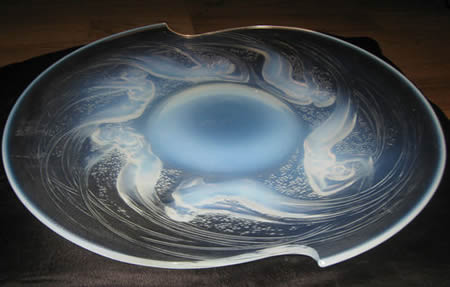
While you are looking at Pinky’s offerings, keep something in mind. It’s not just what an ad says that can cause a buyer to be misled. It’s also what it doesn’t say. The seller in this case is a regular dealer in R. Lalique. When you look at the first ad at the link below, think about not just what the ad does tell you, but what this Lalique Dealer doesn’t tell you.
And our usual reminder that the motivation of the seller is irrelevant to your decision about buying from or dealing with a particular seller. A seller may not be intentionally misleading or purposefully putting out false information, they might believe their own false claims. But purposeful or not, the end result of relying on false claims is the same for the buyer. So it’s not really worth spending a ton of time pondering the question of malice or ignorance. The damage to a buyer can be just as great from dealing with an ignorant dealer as a dishonest one. We’ve railed* before that if you are going to buy from a regular seller of R. Lalique, how important it is to deal with a competent and honest dealer. So we deem it best to just be as knowledgeable as possible and to avoid dealers that fall into either category.
With all that said, here is the title of the first offering:
rene lalique opalescent glass ondines plate c 1921 marcilhac 3003.
This representation from this regular seller of R. Lalique items appears in the ad:
“very unusual shape of plate no chips /cracks/or hairlines”
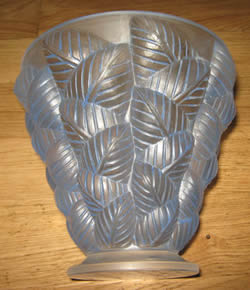 A representation that word by word could be claimed to be true. We can see you at the used car dealer now, when the salesman tells you the car you are looking at has no dents, no scratches, and no paint chips of any kind! The only problem is that the front bumper, both front fenders, and the hood are missing. But not a scratch, not a dent, and no paint chips anywhere. Hmmmmmmmm. A representation that word by word could be claimed to be true. We can see you at the used car dealer now, when the salesman tells you the car you are looking at has no dents, no scratches, and no paint chips of any kind! The only problem is that the front bumper, both front fenders, and the hood are missing. But not a scratch, not a dent, and no paint chips anywhere. Hmmmmmmmm.
The second listing is titled:
rene lalique vase “moissac” thickly adjoining pointed leaves c 1927 model no 992.
Funny how these footed Moissac Vases with R. Lalique signatures always seem to come thru a dealer. Note in the photo below that in this example the R. does not appear to line up with or match LALIQUE.
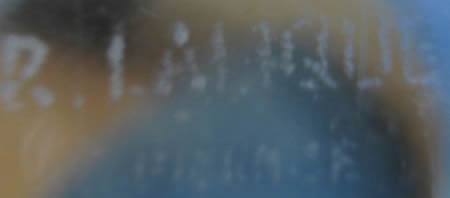
We don’t know of any evidence that these footed Moissac Vases were made before the war. That is why footed Moissacs do not appear in the Rene Lalique Catalogue here at R.Lalique.com. We also note that they do not appear in the 2011 R.Lalique Catalogue Raisonne by Monsieur Marcilhac. We of course would welcome any factual evidence from anyone to back up the claim that these Moissac Vases with the wide base are authentic pre-war R. Lalique items.
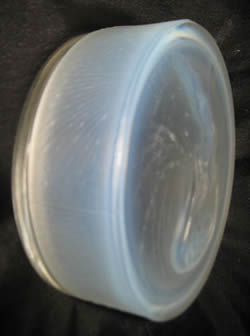 The third and final listing we want to bring to your attention has met the difficult task of hitting a trifecta** of issues in just one listing. A trifecta within a trifecta when considering the entire situation really. The third and final listing we want to bring to your attention has met the difficult task of hitting a trifecta** of issues in just one listing. A trifecta within a trifecta when considering the entire situation really.
Item 251231416506 stunning rene lalique d orsay powder box of mythological maidens c1920!
1. The glass bottom to the box is not original to the piece. Hard to have a box without the bottom. Not a lot of picture is given to that glass bottom in the photos. “pristine condition” is the claim at the top of the ad from this regular seller of R. Lalique items.
2. The box appears to be cut down. The molded signatures are not shown on the lower portion of the top piece where you would expect to find them. “pristine condition” is the claim of this regular seller of R. Lalique items.
3. This is almost laughable. Pinky shows you two pictures of a signature in the ad. But they aren’t from the box, we think they’re likely from a Gui Vase. Now that’s a mark of authenticity and reliability when a seller shows you photos of the signature, even when it’s not on the piece in the ad, right?
So to review, we have a mutilated plate with no cracks, chips, or hairlines, a highly questionable vase, and likely just part of the top of a box, mated with a bottom not original to the top, and a signature from some other item showing in the ad. Oh yea about the box… “pristine condition”.
All for sale at the same time by the same lalique dealer. Do you think this dealer may have had his share of complaints? Check out the comments about Pinky from some satisfied customers:
I purchased it as a relisted item …ignored emails and then said “dog ate it”
Seller response to my query was abusive
BEWARE OF SELLER!!!!!!!!
Item had big chip not described at all in description. I wouldn’t buy from again
BEWARE .THIS SELLER DOES NOT TELL THE TRUTH. USE YOUR BUYER BEWARE WISELY!!!!!!!
Item had faults not described at all in description. I wouldn’t buy from again.
Worst transaction I’ve had, never again!!
Item damaged. Was returned. They relisted as PRISTINE !!!!!!!!!
Seems like more than your run-of-the-mill*** issues for a seller with a 123 feedback rating.
If more R.Lalique listings with questionable and/or outright false claims continue to appear from Pinky, we’ll update this article with the new material from time to time.
* Railed is used as the past tense of the verb “rail” – to strongly espouse a position. An example would be “The speaker railed against corruption in politics.” Typically you would “rail” against something. Here, we “rail” for something.
** A Trifecta in horse racing is correctly picking the top three finishers in order in a race. But like so many other sporting expressions, it is now used more off-handedly to include any triple accomplishment, be it good or bad. Consider a lousy restaurant trifecta – bad service, horrible food, and high prices.
*** Run-Of-The-Mill is an American expression from the late 1800’s ramp-up into the industrial age, where ordinary production of items from a mill, nothing special, were referred to as run-of-the-mill. It’s now used in a variety of run of the ____ phrases to mean ordinary, common, or usual.
Posted in Articles of Interest to Collectors, R Lalique - Rene Lalique Authentication Identification, R Lalique and Rene Lalique Fakes-Copies-Frauds | 2 Comments »
Rene Lalique Senlis Vases – Rene Lalique Cluny Vases: R. Lalique Collector Alert
December 17th, 2012
The appearance of the heavily damaged, cracked and stapled dark glass R. Lalique Senlis Vase at Skinner’s Auction House in Boston on December 15th provides a good opportunity to bring to your attention the potential for trickery in the sale of Cluny and Senlis Vases, two great R. Lalique models.
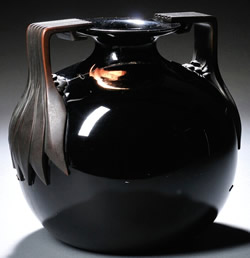 Both the Senlis and Cluny Vase models are based on an undecorated glass body with two bronze mounts. The Senlis bronze has a leaf decor, the Cluny a more intricate masque and serpents motif. The bronze mounts are held in place thru an attachment on the inside of the vase which secures a protrusion emanating from the bronze that goes thru a drilled hole from the outside to the inside of the vase. The location of the hole is behind the masque on the Cluny and behind the largest part of the leaf on the Senlis. Both the Senlis and Cluny Vase models are based on an undecorated glass body with two bronze mounts. The Senlis bronze has a leaf decor, the Cluny a more intricate masque and serpents motif. The bronze mounts are held in place thru an attachment on the inside of the vase which secures a protrusion emanating from the bronze that goes thru a drilled hole from the outside to the inside of the vase. The location of the hole is behind the masque on the Cluny and behind the largest part of the leaf on the Senlis.
The drilled hole has caused some issues over time as the different expansion rates of the glass and the bronze during temperature changes as well as the contact of the attachment and the glass at the point of the drilled hole has resulted in many examples with spider or more severe cracks. In addition there are vases of both models that have just been damaged over time from any kind of impact from dropping, bumping, hitting a shelf, etc. And there are plenty of other ways to crack a glass vase; even something as simple as leaving it in a spot where it is heated up rapidly by strong sunlight can do the trick in many instances. And in the case of these two models, grabbing it hard enough by one of the mounts could also cause damage.
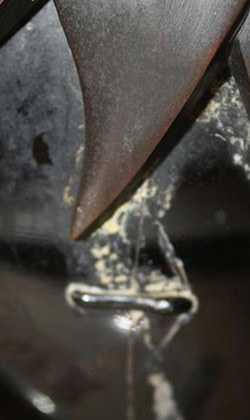 The problem that has been created is that the undecorated glass body of the vase can be duplicated! Yes, it is not all that difficult to make a credible copy of the plain glass body, drill holes in it, and attach a set of handles removed from a damaged Cluny or Senlis. Especially with the current pricing in the market of these vases (a Cluny recently made near $200,000 at auction), the cost of creating a new glass body is nothing compared to the value of an undamaged example. The problem that has been created is that the undecorated glass body of the vase can be duplicated! Yes, it is not all that difficult to make a credible copy of the plain glass body, drill holes in it, and attach a set of handles removed from a damaged Cluny or Senlis. Especially with the current pricing in the market of these vases (a Cluny recently made near $200,000 at auction), the cost of creating a new glass body is nothing compared to the value of an undamaged example.
So just checking the math here, an extensively cracked and stapled Senlis Vase sells for $3000 plus commissions. A perfect Senlis Vase is worth for arguments sake $150,000 – $200,000. So you have a bit of room, say roughly $145,000 to $195,000 of room in this example to create a new body! Heck, super models don’t even spend that much to transform their bodies. And note that we do not know the identity of the buyer of the cracked and stapled Skinner’s Senlis Vase. We are just using its appearance to help increase the awareness of our readers. For all we know the buyer may be a collector that was happy to get the stapled version for 98% less than the cost of one that’s in good order. Or someone may have wanted the bronze mounts to use as custom door pulls on a set of doors (not a bad idea). Heck, some Art History PHD candidate doing a thesis on the history of glass repair could have bought it. You get the point.
However, this writer was reliably informed that at least one R. Lalique dealer has in fact commissioned the making of a new glass body to replace a damaged Senlis/Cluny glass body and thus created an undamaged example from a nearly worthless one.
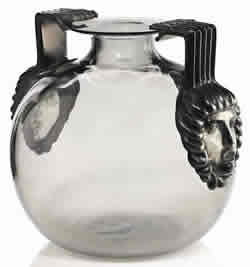 So, is there anything wrong with “fixing”, some would say “saving” a damaged vase in this fashion? Of course not, so long as you make mention of it when you sell it! So, is there anything wrong with “fixing”, some would say “saving” a damaged vase in this fashion? Of course not, so long as you make mention of it when you sell it!
This brings us back to our often sung refrain: When doing business with a dealer, make certain that the dealer is honest and knowledgeable. Not just honest, and not just knowledgeable, but both honest and knowledgeable.
How can you know? Well, you can ask other collectors that have been collecting for a long time. You can search the internet for information by typing into a search engine the name of the dealer along with other phrases such as lalique, or a city or company name etc. You can ask the dealer for references from collectors that the dealer has a longstanding relationship with. And you can get independent advice concerning your purchases.
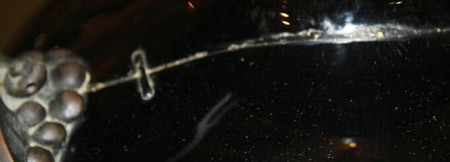
To summarize, the point about the Cluny and Senlis Vases and the dealers you choose to do business with is simply to be smart and be careful. Arm yourself with the most knowledge you can. And be as wise in spending your money as you are in making it. Amen.
Tags: R Lalique and Rene Lalique Fakes-Copies-Frauds, R Lalique Vases and Rene Lalique Vases
Posted in Articles of Interest to Collectors, R Lalique and Rene Lalique Fakes-Copies-Frauds | No Comments »
Lalique Jewelry At The Nelson-Atkins Museum World’s Fair Exhibition: Three Rene Lalique Jewels On Display – Great R. Lalique!
May 19th, 2012
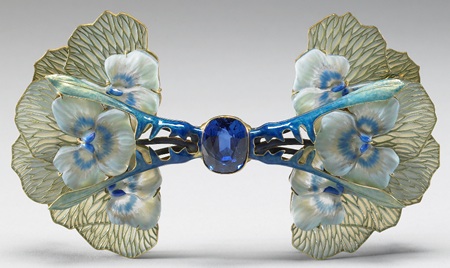
In 1911, former Kentucky and Missouri schoolteacher Mary McAfee Atkins died at the age of 75. When her husband died 25 years earlier in 1886, he had left here about $250,000, which by the time of her death had become $1,000,000 (this at a time when $1,000,000 was a lot of money of course).
 She left $300,000 in her will to her adopted home town “… for the purchase of necessary ground in Kansas City, Missouri, and the creation of a building to be maintained and used as a Museum of Fine Arts for the use and benefit of the public.” She left $300,000 in her will to her adopted home town “… for the purchase of necessary ground in Kansas City, Missouri, and the creation of a building to be maintained and used as a Museum of Fine Arts for the use and benefit of the public.”
One notable event during the period when Mrs. Atkins was a widow, and just a country mile from her Kansas City, Missouri home, was the 1904 Louisiana Purchase Exposition in St. Louis Missouri. A major World’s Fair (how could it be a World’s Fair and not be major is a good question), it was attended by the likes of Teddy Roosevelt, Geronimo…yes THE Geronimo, Henri Poincare, T.S. Eliot, Helen Keller, and too many more people and companies to mention. Well except one of course, because Rene Lalique objects were exhibited and sold in St. Louis. And it was there that Henry Walters, the eldest son of William Thompson Walters, a wealthy Baltimore (by way of Liverpool Pennsylvania) liquor trader and railroad man, would see and purchase some great Lalique Jewelry on exhibit at the St. Louis Exposition.
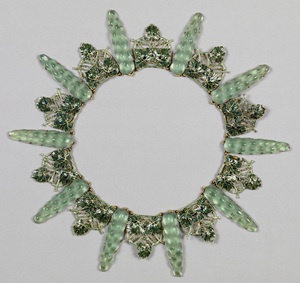 Walters would die in 1931, leaving his palazzo like art house and contents to the City of Baltimore. It remains today, over 75 years after its opening in 1934, as The Walters Art Museum. And it has about a dozen great pieces of R. Lalique in its 35,000 object collection; a collection that coincidentally contains about the same number of objects as the Museum which is the main point of our story. A story we shall now resume :). Walters would die in 1931, leaving his palazzo like art house and contents to the City of Baltimore. It remains today, over 75 years after its opening in 1934, as The Walters Art Museum. And it has about a dozen great pieces of R. Lalique in its 35,000 object collection; a collection that coincidentally contains about the same number of objects as the Museum which is the main point of our story. A story we shall now resume :).
In 1915, four years after the death Mrs. Atkins, William Rockhill Nelson, the man who founded the Kansas City Star Newspaper died. He left the bulk of his large estate in a trust, the income to be used for the purchase of artworks such as paintings, sculptures, books, tapestries, and engravings “…for the delectation** and enjoyment of the public generally.” The estates of a couple other Nelson family members and Mr. Nelson’s lawyer also left additional funds for the same purpose.
 These Atkins and Nelson bequests were unrelated and each estate had its own plans. So it would be some time before events would take their course and these two different bequests would join purpose and coalesce into something tangible for an even greater public good. But coalesce they did, and with trustees for the schoolteacher, the publisher, and the local government working together, in December 1933, at the height of the great depression, on the grounds of Nelson’s former mansion, the new museum was opened to the public. The cost was a striking 2.75 million dollars. These Atkins and Nelson bequests were unrelated and each estate had its own plans. So it would be some time before events would take their course and these two different bequests would join purpose and coalesce into something tangible for an even greater public good. But coalesce they did, and with trustees for the schoolteacher, the publisher, and the local government working together, in December 1933, at the height of the great depression, on the grounds of Nelson’s former mansion, the new museum was opened to the public. The cost was a striking 2.75 million dollars.
The whole plan started off with land and money, but without much art. But with wildly depressed prices for fantastic artwork due to the depression, the new museum was quickly able to create a world-class collection across many fields.
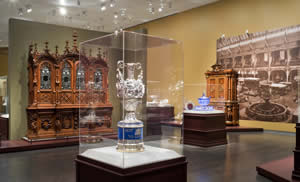 Coincidently, the museum architecture was modeled after the classic design of the Cleveland Museum of Art, which recently put on its own World’s Fair Exhibition around the objects of Lalique, Tiffany, and Faberge from the Paris Exposition of 1900. Coincidently, the museum architecture was modeled after the classic design of the Cleveland Museum of Art, which recently put on its own World’s Fair Exhibition around the objects of Lalique, Tiffany, and Faberge from the Paris Exposition of 1900.
Fast forwarding in our walk down Midwestern art history lane, in the early part of our new century, the Museum space was expanded for the first time, to nearly 400,000 square feet with the addition of about 165,000 square feet in the new Bloch Building. The Bloch Building was named after the Chairman of the Board of Trustees of the Nelson-Atkins Museum, Henry Bloch and his wife Marion; Henry being the H in H & R Bloch.
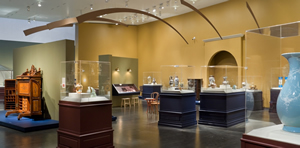 And it is at the Nelson-Atkins Museum Of Art in Kansas City Missouri, born of the generous mid-western philanthropic and charitable mindset that is a hallmark of the American character, as part of their amazing and creative exhibition “Inventing the Modern World: Decorative Arts at the World’s Fairs, 1851–1939” that our story comes together. And it is at the Nelson-Atkins Museum Of Art in Kansas City Missouri, born of the generous mid-western philanthropic and charitable mindset that is a hallmark of the American character, as part of their amazing and creative exhibition “Inventing the Modern World: Decorative Arts at the World’s Fairs, 1851–1939” that our story comes together.
This exhibition makes the point that all these various World’s Fairs were the embodiment of the then leading design and artistic expression as it stood around the globe. Companies and countries brought their best, and it would be shown in a milieu of the best, newest, most innovative products from dozens of countries and hundreds of companies. These Fairs were more than just big car boot sales looking for buyers. They developed into an expression of the state of art, design, and technology of the day. In the time before routine international travel, before computers and the World Wide Web, before the television, and in many cases before cars, planes, telephones, cameras, radios and even electric lights, these Fairs were the place you could go to see what would astound you in a time when the world was a larger, much more unfamiliar, and stranger place.
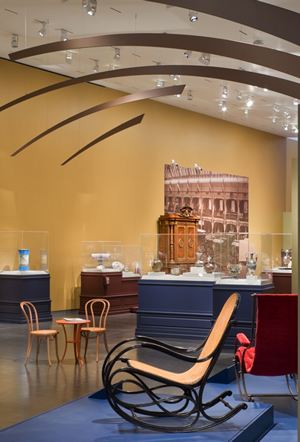 It’s only natural that among the makers who would not shy away, but would savor the chance to bring the a-game*** to such a gathering, would be the great Rene Lalique. Be it Paris in 1900 or 1925, St. Louis in 1904, or anywhere else on the globe that the leading artistic endeavors of the day would meet and be compared side by side, Rene Lalique was an anxious participant. And it was that country mile from the schoolteacher and the publisher, a perfect place for the great Lalique to show his goods half a world away from home, that Henry Walters bought, retained, and donated for the public delectation, two of the three pieces of phenomenal Lalique Jewelry that have once again made the trip back to where they first met the American public eye, in Missouri. It’s only natural that among the makers who would not shy away, but would savor the chance to bring the a-game*** to such a gathering, would be the great Rene Lalique. Be it Paris in 1900 or 1925, St. Louis in 1904, or anywhere else on the globe that the leading artistic endeavors of the day would meet and be compared side by side, Rene Lalique was an anxious participant. And it was that country mile from the schoolteacher and the publisher, a perfect place for the great Lalique to show his goods half a world away from home, that Henry Walters bought, retained, and donated for the public delectation, two of the three pieces of phenomenal Lalique Jewelry that have once again made the trip back to where they first met the American public eye, in Missouri.
And that fortuitous sale back in 1904 could not have occurred in a more apt setting. For Missouri is known throughout America as the “Show Me” state, an expression attributed**** to Missouri Congressman Villard Vandiver who in 1899 is reported to have said in a speech, “I come from a state that raises corn and cotton and cockleburs and Democrats, and frothy eloquence neither convinces nor satisfies me. I am from Missouri. You have got to show me.” Just the place for Rene Lalique.

The Nelson-Atkins Inventing The Modern World Exhibition, bringing in objects from so many World’s Fairs held over nearly 90 years, allows a visitor to see the artistic and technological progression as time moved through the industrial revolution and the age of invention. And it allows viewing each Fair and its objects in the context of the flow of history, not just for design and industry, but culturally as well. Because wrapped up in each object on display is the ability, the talent, the aspirations of the artist, and the state of the industry and the cultures from which they sprang.
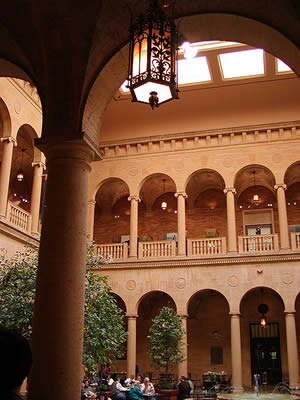 In addition to the wonderful Pansy Brooch and Grape Necklace from The Walters, is the amazing Wasps Stickpin exhibited at the Exposition Universelle de Paris in 1900. This stickpin has been lent by the Design Museum in Copenhagen Denmark. All three objects are stunning in their overall artistic concept, presentation and detail. And all three are trademark Rene Lalique; natural world motifs magnificently executed using materials for what they bring to the artistic nature of the project, and not just creating holders for valuable gems. In addition to the wonderful Pansy Brooch and Grape Necklace from The Walters, is the amazing Wasps Stickpin exhibited at the Exposition Universelle de Paris in 1900. This stickpin has been lent by the Design Museum in Copenhagen Denmark. All three objects are stunning in their overall artistic concept, presentation and detail. And all three are trademark Rene Lalique; natural world motifs magnificently executed using materials for what they bring to the artistic nature of the project, and not just creating holders for valuable gems.
Note that each of the three Lalique Jewels is documented in the seminal work Rene Lalique Schmuck und Objets d’art 1890 – 1910 by Sigrid Barten, which is available for purchase in our Library. The Grapes Necklace is Object 346 and can be found on Page 246. The Wasps Stickpin is Object 1400 on Page 478, and the Pansy Brooch is Object 1061 on Pages 414-415.
The Nelson-Atkins is open Wednesdays 10 to 4, Thursdays and Fridays from 10 to 9, Saturdays 10 to 5, and Sundays Noon to 5. You know what we said earlier about the mid-western mindset? Admission is free. While you’re there, you might want to check out the other stuff they have as well :). Visit their website or call them at 816-561-4000 for more information.
The Exhibition will be at the Nelson-Atkins through August 12th, 2012. It will then move to the Carnegie Museum of Art in Pittsburgh for the period October 13th, 2012 to February 24, 2013. On April 14, 2013 it will open at the New Orleans Museum of Art and remain there until August 4, 2013. It will then move to its final stop at The Mint Museum in Charlotte, North Carolina from September 21, 2013 to January 19th, 2014.
 You can also visit the R.Lalique Jewelry section of the Rene Lalique Biography here at RLalique.com, where you will find links to all the great jewelry resources on the site. And visit the Lalique Museum page for a listing and links to over 80 different museums worldwide that have works of Rene Lalique in their collections. This list includes the Nelson-Atkins Museum of Art as their collection contains a great looking black glass Lezards et Bluets Vase and a Sauterelles Vase, The Walters Art Museum, The Design Museum Denmark in Copenhagen, the Carnegie Museum of Art, and the New Orleans Art Museum. You can also visit the R.Lalique Jewelry section of the Rene Lalique Biography here at RLalique.com, where you will find links to all the great jewelry resources on the site. And visit the Lalique Museum page for a listing and links to over 80 different museums worldwide that have works of Rene Lalique in their collections. This list includes the Nelson-Atkins Museum of Art as their collection contains a great looking black glass Lezards et Bluets Vase and a Sauterelles Vase, The Walters Art Museum, The Design Museum Denmark in Copenhagen, the Carnegie Museum of Art, and the New Orleans Art Museum.
** Delectation means enjoyment or pleasure. So a food that is good might be called delectable, which would be pleasing or delicious. If it’s really good, it could be delectacious, but we’re not sure if that is a real word or not.
*** “a-game” is an American expression which means to bring your best.
**** “show me” as the watchword for Missouri has other claimed origins, none this compelling.
Mrs. Atkins photo from Mr. Denardo.
Three inside photos of the Exhibition by Bob Greenspan.
Tags: R Lalique Exhibitions and Rene Lalique Exhibitions, Rene Lalique Jewelry and R Lalique Jewelry
Posted in Articles of Interest to Collectors, R Lalique, Rene Lalique, and RLalique News | No Comments »
R. Lalique Catalogue Raisonne 2011: Rene Lalique Glass New 4th Edition Of The Works Of The Great Lalique!
September 11th, 2011
A new and updated edition of the R. Lalique Catalogue Raisonne De L’Oeuvre De Verre by Felix Marcilhac was released this week! Lalique’s works are shown in nearly 4000 photos in the 1064 page 4th Edition. UPDATE: The new Lalique Catalogue Raisonne 2011 Edition is in stock here on the website with a special offer of Free Shipping to buyers in the continental U.S. for orders placed by Pearl Harbor Day 2011!
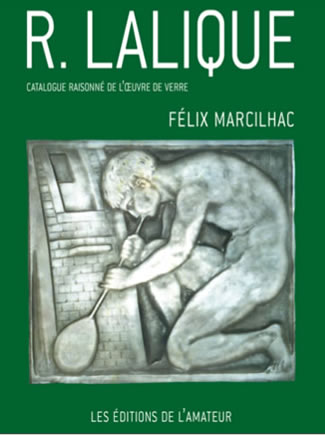 The new edition has arrived just in time for RLalique collectors and Rene Lalique enthusiasts needing this great reference work. The last edition was published 7 years ago in 2004. It has been sold out for several years. Actual sale prices have risen north of $750 (sometimes well north) in our R. Lalique For Sale section, and on Ebay for the 2004 Lalique Catalogue Raisonne, and are quoted at over twice that at some online services. The new edition has arrived just in time for RLalique collectors and Rene Lalique enthusiasts needing this great reference work. The last edition was published 7 years ago in 2004. It has been sold out for several years. Actual sale prices have risen north of $750 (sometimes well north) in our R. Lalique For Sale section, and on Ebay for the 2004 Lalique Catalogue Raisonne, and are quoted at over twice that at some online services.
The new edition of R Lalique, released in the last week, has a suggested retail price of €250, or about $350 at today’s exchange rates. There have already been well over a dozen of these change hands on Ebay at a 5% discount to list, or €237.50 (about $330), plus €70 to €87 (about $100 to $120) of shipping charges for buyers outside of France, where the current sellers are located. So a total delivered price of around $425 to $450.
 The total price still represents a major drop from recent sales of older editions, and while some sellers are still hoping against hope (there is one listing currently on Ebay for a 2004 Edition for $1500), others have quickly brought their prices down below the cost of the new book to reflect the new reality. The total price still represents a major drop from recent sales of older editions, and while some sellers are still hoping against hope (there is one listing currently on Ebay for a 2004 Edition for $1500), others have quickly brought their prices down below the cost of the new book to reflect the new reality.
A quick summary of the 4 Editions (each new edition adding new and correcting info):
Year: 1989 Dust jacket: Black
Year: 1994 Dust jacket: Blue
Year: 2004 Dust jacket: Red
Year: 2011 Dust jacket: Green
We expect within the next couple of weeks to have this new edition for sale in the Rene Lalique Books section of the site. It is likely that all potential buyers of this book, and especially U.S. buyers, will have their patience rewarded with a decent amount of savings if they wait for the book to appear at what has become THE address on the web for everything R Lalique! UPDATE: The new Lalique Catalogue Raisonne 2011 Edition is in stock here on the website with a special offer of Free Shipping to buyers in the U.S. that purchase by Pearl Harbor Day!
Tags: R Lalique and Rene Lalique Library
Posted in Articles of Interest to Collectors, R Lalique - Rene Lalique Authentication Identification, R Lalique, Rene Lalique, and RLalique News | No Comments »
R.Lalique Glass Church: Rene Lalique Architectural & Religious Lalique Glass: St. Matthew’s Church in Jersey
August 18th, 2011
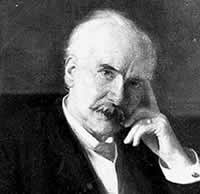 In 1860, the year before the American Civil War started, 10 year old Jesse Boot of Nottingham England began helping his mother run the family medicine shop when his father John died. By age 13 he left school to concentrate on his work in the shop. In the ensuing decades, Jesse would turn the single medicine shop into the major national chain Boots the Chemists. 60 years later in 1920, he sold control of the “Chemists to the Nation” to an American company. Jesse died on the Channel Island of Jersey 11 years later in 1931. In 1860, the year before the American Civil War started, 10 year old Jesse Boot of Nottingham England began helping his mother run the family medicine shop when his father John died. By age 13 he left school to concentrate on his work in the shop. In the ensuing decades, Jesse would turn the single medicine shop into the major national chain Boots the Chemists. 60 years later in 1920, he sold control of the “Chemists to the Nation” to an American company. Jesse died on the Channel Island of Jersey 11 years later in 1931.
Along the way Boot would be knighted Sir Jesse Boot (1909), create a baronet (1917), and in 1929, become Baron Trent of Nottingham, (not as cool as Sheriff, but still a great title:), aka Lord Trent. He did not live to see his son John, the 2nd Baron Trent and his own father’s namesake, re-acquire control of the chain in 1933 in the midst of the depression.
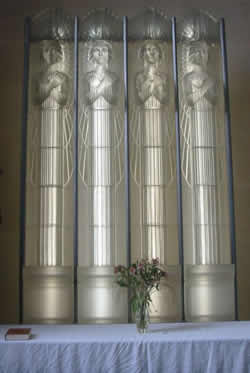 Boot was also a philanthropist, especially in Nottingham and in Jersey. For one of many examples, he donated the land for what is now the University of Nottingham, which opened in 1928, where the Jesse Boot Chair in Chemistry was named in his honor. Boot was also a philanthropist, especially in Nottingham and in Jersey. For one of many examples, he donated the land for what is now the University of Nottingham, which opened in 1928, where the Jesse Boot Chair in Chemistry was named in his honor.
Boot’s wife, Lady Florence Trent (her maiden name was Florence Rowe) survived him. She kept her principal residence in Jersey, the place they had first met. But Lady Trent also kept a residence on the French Riviera in Cannes, where fortuitously, a famous Frenchman also kept a home; a man who like her deceased husband, had achieved phenomenal success satisfying the new consumer demand created by the industrial revolution. Yes readers, Rene Lalique kept a place in Cannes and was a neighbor of Lady Trent.
In 1932, the year after her husband’s death, Lady Trent asked her neighbor to design new interior fittings in glass for the 1840’s era St. Matthew’s Church of Millbrook located just across the road from her Jersey home which she called Villa Millbrook. It was to be a major architectural undertaking in honor of Baron Trent and Lalique agreed to take the commission. Two years later, in 1934, Lalique’s fabulous undertaking was completed and installed in St. Matthew’s, complemented by additional interior modifications by the Jersey architect A.B. Grayson, an accomplished art deco designer, most notably of private homes.
Lalique glass includes the communion rail, communion table, screens, the altar cross and pillars, a Lalique glass font, window and door panels, and a reredos (altar screen). The art deco Lalique design highlights include angelic figures and Jersey lilies.
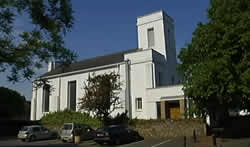
Today St. Matthew’s remains a functioning community place of worship. But owing to the amazing work of the great Lalique, it is better known worldwide as “The Glass Church”. So it’s also an Art Deco treasure of Jersey and a tourist attraction in addition to being a religious establishment.
Last year, the 170 year old Church commenced its first major renovation in over 70 years. The total cost is estimated at £1,000,000. We were alerted to the renovation a year ago through a BBC article which detailed the renovation project and linked out to three reference sources: the “States of Jersey” website, the “Glass Church” website, and to the “Rene Lalique Worldwide Gathering Place”! How great is that? The overhaul is planned to include:
Conservation to the Lalique Glass and the supporting structures of the glass.
New roof.
Restoration of the bell housing and bells.
Replace the electrical wiring and update the lighting.
New heating system.
Interior redecoration and new landscaping.
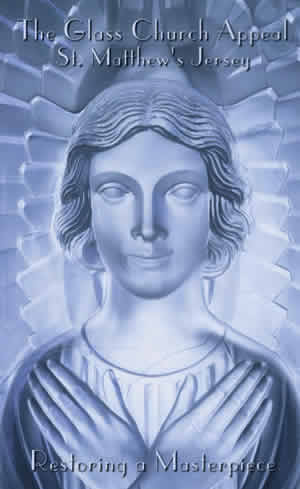 An organization named The Friends of the Glass Church has been set-up under the auspices of the Lieutenant Governor of Jersey, Lieutenant General Andrew Ridgway, to raise funds for the renovations. They have already raised approximately £140,000 toward the project. Updating of the roof was finished in 2010. Also the States of Jersey has approved a matching funds grant of £125,000. Phase two, which is the refurbishment of the bell tower, bells, and some asbestos removal, should be completed in early October, at which time the church will re-open. An organization named The Friends of the Glass Church has been set-up under the auspices of the Lieutenant Governor of Jersey, Lieutenant General Andrew Ridgway, to raise funds for the renovations. They have already raised approximately £140,000 toward the project. Updating of the roof was finished in 2010. Also the States of Jersey has approved a matching funds grant of £125,000. Phase two, which is the refurbishment of the bell tower, bells, and some asbestos removal, should be completed in early October, at which time the church will re-open.
Details of how you can contribute to the project can be found at the Friends of the Glass Church website or the Church’s website, both of which are linked previously. We urge you to consider generously supporting this uniquely Rene Lalique effort.
We spoke with church officials in preparation for this article and were given the following visitor information:
Visitors are welcome at the Church Monday thru Friday from 9:00 AM to 5:30 PM. The Church is closed on Saturdays. Regular services are held on Sunday at 11:00 AM and visitors are welcome to attend.
 St. Matthew’s home, the island of Jersey has a rich history owing to its location between France and England. It has a population of around 100,000, and both French and English are spoken there. Jersey is a separate possession of the crown; it’s a dependency and not part of the United Kingdom. It even has its own currency, though several other currencies also circulate on the island. It’s a crossroads of cultures and activities. St. Matthew’s home, the island of Jersey has a rich history owing to its location between France and England. It has a population of around 100,000, and both French and English are spoken there. Jersey is a separate possession of the crown; it’s a dependency and not part of the United Kingdom. It even has its own currency, though several other currencies also circulate on the island. It’s a crossroads of cultures and activities.
If you plan to visit, almost everything you ever wanted to know about Jersey can be found at their Jersey.com website, including travel, lodging, attraction and activity choices.
And finally, if you’d like to see many examples of architectural elements created by Rene Lalique, check out the Lalique Architectural Glass page in the R. Lalique Catalog here on the website.
Tags: R Lalique Architecture - Rene Lalique Architecture, Rene Lalique Biography, Rene Lalique History and R Lalique History
Posted in Articles of Interest to Collectors, R Lalique and Rene Lalique History | No Comments »
R Lalique Signatures: Authentic Rene Lalique Signatures – Samples of Lalique’s Marks
July 6th, 2011
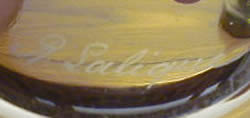 Rene Lalique pieces show many different authentic R. Lalique signatures and we get regular inquiries asking where R. Lalique owners or collectors can go to see samples of actual R. Lalique signatures. In response, we’ve developed a page where readers can review the different signatures found on genuine pieces of R. Lalique. This new page showing how R. Lalique pieces were signed can coincidentally be found at this link: R.Lalique Signatures. Rene Lalique pieces show many different authentic R. Lalique signatures and we get regular inquiries asking where R. Lalique owners or collectors can go to see samples of actual R. Lalique signatures. In response, we’ve developed a page where readers can review the different signatures found on genuine pieces of R. Lalique. This new page showing how R. Lalique pieces were signed can coincidentally be found at this link: R.Lalique Signatures.
We also thought this would be a good time to answer some questions that come up quite regularly about the signatures found on R Lalique. This is not intended as a comprehensive discussion, but merely to answer common questions about Lalique’s signatures on his R. Lalique glass and other items. Jumping right in:
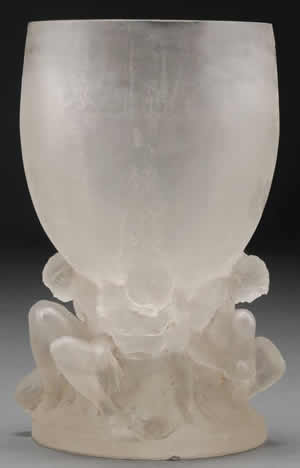 1. Is every piece of R. Lalique signed? 1. Is every piece of R. Lalique signed?
In the big picture of Rene Lalique’s works that were produced, by the percentages it is fair to say that the overwhelming majority of R. Lalique was signed in one form or another. However, Lalique produced a lot of pieces, so just a miniscule unsigned percentage can mean that many pieces were not signed with an R. Lalique mark. It appears that architectural items, especially parts of larger installations can be unsigned with some regularity (considering how irregularly these types of pieces appear that is :). And an apparently authentic (and original) piece appears without a signature from time to time. However, it would be a mistake in our opinion for the average collector to think they had found the pot of gold at the end of the Rene Lalique rainbow each time or any time an unsigned something or other popped up represented as R. Lalique, on one of the slim chances mentioned (or not mentioned) above. So we typically advise collectors to proceed in life as if everything was signed and should be signed. Basically, nearly every single piece percentage wise was signed, so why mess around. And when you go to sell, it’s usually much better to have a signed piece of R. Lalique than an academic explanation of why the unsigned piece is authentic. Note: The apparent cire perdue vase shown here appeared at auction advertised as unsigned and sold for over $100,000. We didn’t have the vase in-hand, so we don’t know one way or the other if it was in fact an unlikely unsigned R. Lalique Cire Perdue vase. However, it appears that at least two bidders were satisfied on the subject.
2. Does every authentic signature contain the phrase “R Lalique”?
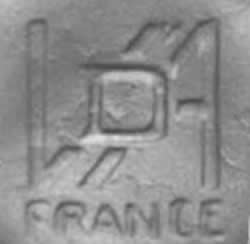 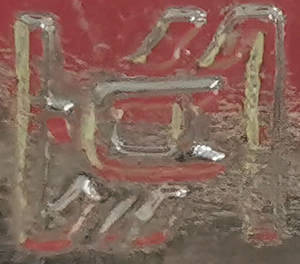 No, not all signatures or marks contain the phrase “R. Lalique”. Some exceptions would be jewelry with metal backing is many times stamped LALIQUE in the metal, and may or may not be signed on the glass. No, not all signatures or marks contain the phrase “R. Lalique”. Some exceptions would be jewelry with metal backing is many times stamped LALIQUE in the metal, and may or may not be signed on the glass.
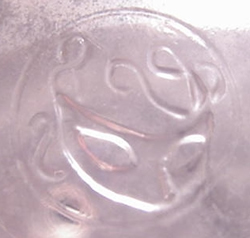 There are 2 different VDA molded marks, one with FRANCE molded under it and one without FRANCE. VDA stands for Verrerie D’Alsace which is French for Alsatian Glassware. There’s also the Masque mark shown here. These 3 marks do not say R. Lalique. There are also some pieces signed just Lalique in the glass, either inscribed or in the mold. And there are a small number of items with just R L in the mold. Those are mainly (but not always) perfume bottles with small bases. So while most of what appears is signed R Lalique in one form or another, many pieces are signed differently. There are 2 different VDA molded marks, one with FRANCE molded under it and one without FRANCE. VDA stands for Verrerie D’Alsace which is French for Alsatian Glassware. There’s also the Masque mark shown here. These 3 marks do not say R. Lalique. There are also some pieces signed just Lalique in the glass, either inscribed or in the mold. And there are a small number of items with just R L in the mold. Those are mainly (but not always) perfume bottles with small bases. So while most of what appears is signed R Lalique in one form or another, many pieces are signed differently.
3. Is each example of the same R. Lalique model signed the same way, or can the same models have different signatures?
Many models can be found with different signatures that were used over time. It seems that the more popular a piece, or the longer it was in production, the more different signatures are seen.
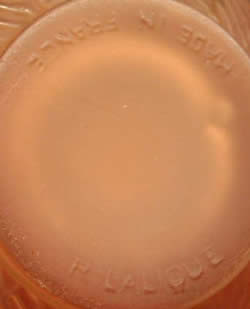
4. Is it true that no R. Lalique piece has “Made In France” signed on it?
No, there are a few pieces that have the phrase “Made In France”. For example, some Palmes Vases have a molded R. Lalique and Made In France on the underside as shown here. Another example is one of the Figurines Atomizers with a similar molded signature. Also some Tzigane Perfume Bottles for Corday are molded BOTTLE MADE IN FRANCE R. LALIQUE.
5. Do any R.Lalique pieces have more than one signature or mark?
Yes, a good number of pieces (but again, small percentage wise in terms of overall production) have more than one signature. Three examples:
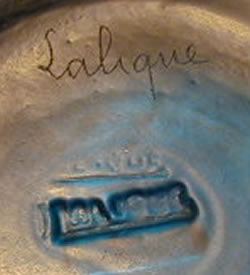 A. We sometimes see pieces with molded signatures that are perfectly readable, with a full R. Lalique France engraved or etched signature present as well. On the R. Lalique Signatures Page linked in the first paragraph above, we currently have a couple examples of double signatures at the end of the page, and more may be added over time. A. We sometimes see pieces with molded signatures that are perfectly readable, with a full R. Lalique France engraved or etched signature present as well. On the R. Lalique Signatures Page linked in the first paragraph above, we currently have a couple examples of double signatures at the end of the page, and more may be added over time.
B. The molded signature is faint or unreadable, so an inscribed signature is added. This is pretty typical on the Escargot Vase for example, where the molded signature is often quite faint, and a script Lalique is added. Shown here is a Courges Vase with the added script Lalique, as well as multiple signatures relevant to the following paragraph.
C. Whatever instrument or technique was used to impress an intaglio signature skipped (or who knows what), and more than one signature was impressed in the piece. We have seen up to six identifiable signatures on one piece. Shown following is a somewhat typical Courges Vase signature, a model that is often seen with multiple signatures.
6. When a piece is signed in script: R Lalique France #888, what does the number stand for?
This is the Rene Lalique et Cie model number to identify the model of the piece, which in this case is a Sauterelles Vase.
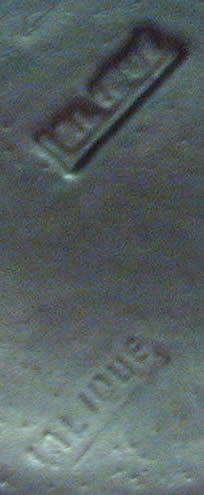 7. Do all pieces contain the word France in the signature? 7. Do all pieces contain the word France in the signature?
No. Early produced pieces do not contain the word France. Our understanding is that no later than with the Tariff Act of 1930, the United States required the country of origin to be marked on imported goods. The USA being the biggest import market in the world on an overall basis at that time (and it still is the largest by far to this day (2019) if you were wondering), stuff all over the world that might be exported started getting the country of origin marked on it at the time of manufacture. This would naturally include Lalique’s great pieces.
8. Are any pieces signed “Rene Lalique”?
Well, never say never. But we are joining the Missouri crowd on this one….. show me.
9. Where were R. Lalique pieces signed?
In France of course!
Seriously, Lalique’s signature appears in many different places on his R. Lalique pieces. They can be signed on the bottom half of the side of a vase for example, anywhere on the underside of the base of nearly any piece, right in the design somewhere, or on the edge of something such as the edge of a box cover or on the side edge of the upper part of a disk shaped seal.
10. Were any pieces made after the death of Rene Lalique signed with an R. Lalique signature?
After World War II, small numbers of pieces were made from old molds that incorporated a molded R. Lalique signature before these molds were updated. However, most of these pieces were also given a modern Lalique France signature to indicate they were post war production. Notable among models that fall into this category are the Coq Nain Car Mascot, the Perche Car Mascot, the Sanglier Car Mascot, the Tete D’Aigle Car Mascot, the Saint-Christophe Car Mascot (all marketed only as paperweights post-war), the Quatre Perruches Frame (also used pre-war only for the Inseparables Clock), and Marienthal Plates. The Meudon Box has been seen several times with the molded R. Lalique signature on the side of the top, but the bottom is engraved Lalique France indicating it was produced after the war. And we have seen the Worth “Stars” Dans La Nuit Perfume Bottle with the molded R. LALIQUE signature but then with an engraved Lalique France as well. Keep in mind that the added post-war signature on any of these examples could later be polished off by an unscrupulous person, leaving only the molded R. Lalique signature. In addition to the above, there are also the molded R. Lalique CREATION signatures on some perfume bottles where the word CREATION tells you it’s post-war.
Further Discussion, Summary, And Resources
If readers that check out the page of Lalique’s signatures have photos of signatures or variations we are missing on that page, please email those in using the link and directions on the signature page. And if you have a question omitted here, or additional information you feel is important to this discussion, please email us using that same link.
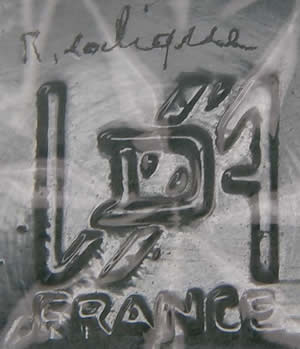 If you are looking for examples of faked, forged, and copied R. Lalique signatures, see them on our site at this link: Faked, Forged, and Copied R Lalique Signatures! You’ll find that many of those faked signatures are quite good If you are looking for examples of faked, forged, and copied R. Lalique signatures, see them on our site at this link: Faked, Forged, and Copied R Lalique Signatures! You’ll find that many of those faked signatures are quite good
In that regard, we wrap up this article with our constant admonition: Signatures do not authenticate pieces, it’s the other way around. Pieces authenticate signatures. Make a decision about the piece first, and then see if the signature fits. Just because a signature looks right, does not mean it is right. And signatures in most cases are far easier to fake than authentic pieces.
To put an emphasis on this point, once or twice a year we see authentic pieces with forged signatures! Usually it’s clearly an attempt to “boost” the signature from what the person thinks is a modern signature to a pre-war signature when no such boost is necessary. For example, a great early vase that was originally signed just Lalique on the lower part of the side in script, and someone adds the R. in front not realizing they have a great and rare thing that does not require further enhancement. And then there’s the example shown here, where someone not knowing that the great molded VDA (without FRANCE) or VDA FRANCE signatures are authentic R. Lalique marks, decides to improve things a bit with an R. Lalique addition. And there is also the occasional piece that for whatever reason (never signed originally, minor polishing or major repair or wear and tear removed the original signature, etc.) that has just a forged signature and none other.
So enjoy your collecting, but do it with your eyes open!
Tags: Articles of Interest to R Lalique Collectors, R Lalique - Rene Lalique Authentication, R Lalique Cire Perdue And Rene Lalique Cire Perdue
Posted in Articles of Interest to Collectors, R Lalique - Rene Lalique Authentication Identification | No Comments »
Rene Lalique Worldwide: R. Lalique Global! Here’s What We’re Talking About: Record! Record! Record!
December 1st, 2010
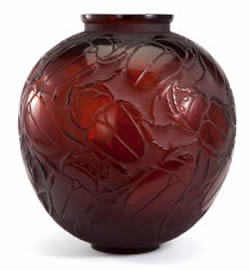 Today, December 1st, 2010, we set the record at RLalique.com for most auctions listed in the Worldwide R. Lalique Auctions Section of the website at one time, with 100 auctions listed coming up around the world that have R. Lalique in them! From Budapest to Boston, and from Melbourne to Manasquan (that’s in New Jersey:), great R. Lalique works coming up for auction such as those pictured here! Global warming has nothing on RLalique.com. At World Headquarters we are HOT! Today, December 1st, 2010, we set the record at RLalique.com for most auctions listed in the Worldwide R. Lalique Auctions Section of the website at one time, with 100 auctions listed coming up around the world that have R. Lalique in them! From Budapest to Boston, and from Melbourne to Manasquan (that’s in New Jersey:), great R. Lalique works coming up for auction such as those pictured here! Global warming has nothing on RLalique.com. At World Headquarters we are HOT!
And, in the don’t break your elbow while patting yourself on the back department (oh yea, we’ve got a department for that too), even more impressive, those auctions are spread around 14 countries! That’s right 14, which is a new record for the number of countries listed at any one time.
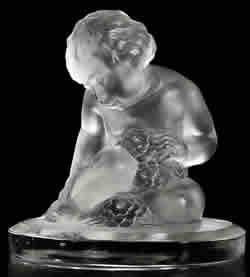 Here’s the country list for inquiring minds: Here’s the country list for inquiring minds:
Australia
Belgium
Canada
France
Germany
Great Britain
Hungary
Italy
New Zealand
Scotland
South Africa
Sweden
Switzerland
United States
We also set a record in the R. Lalique Police Department this month with 50 active listings on the Police Report Page at one time!
As our reach grows and the popularity of the site continues to grows, more and more information flows into World Headquarters and back out to benefit those of you that follow the site and are involved with the output of Rene Lalique.
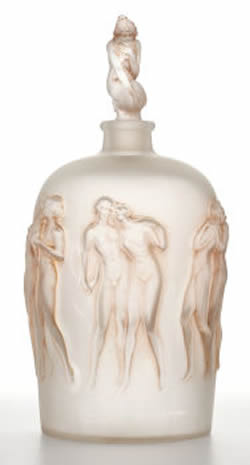 More bidders, more auction action for the works of the great Lalique, more exposure in the art world, more publicity, better prices: Everyone benefits! More bidders, more auction action for the works of the great Lalique, more exposure in the art world, more publicity, better prices: Everyone benefits!
And think about joining the growing list of Collectors and Enthusiasts of the great Lalique that help keep us informed, emailing in auction information, information on fakes news, pricing and results, even condition information if you think it’s important. Pick any email address on the site if you think something will be helpful to the growing worldwide collector community and send it in. You’ll be helping a lot of R. Lalique enthusiasts by getting involved, and you’ll be helping yourself by contributing to the improvement of the collecting and enthusiasts’ field which you have in common with a lot of people you know, and lot more that you don’t.
R. Lalique is setting records. So are we. Spread the word.
Tags: R Lalique RLalique and Rene Lalique Blog, RLalique.com
Posted in Articles of Interest to Collectors, R Lalique Ramblings | No Comments »
Lalique Bacchantes Vase: Post-War Opalescent Cristal Lalique Bacchantes Vase At Roadshow
May 2nd, 2010
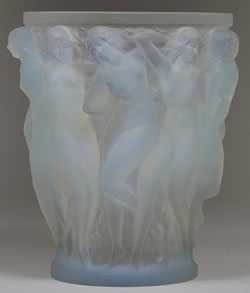 The modern Lalique Company has reproduced the Rene Lalique Bacchantes Vase in crystal basically continuously since production of Lalique crystal began after the end of World War II. These crystal reproductions have continued to bring this iconic Rene Lalique design into the homes of tens of thousands of people worldwide even to this day. The modern Lalique Company has reproduced the Rene Lalique Bacchantes Vase in crystal basically continuously since production of Lalique crystal began after the end of World War II. These crystal reproductions have continued to bring this iconic Rene Lalique design into the homes of tens of thousands of people worldwide even to this day.
The Bacchantes Vase has been reproduced most commonly in clear and frosted crystal, but also yellow amber and gray colored crystal as well.
Unfortunately, some of these modern crystal vases have appeared with altered signatures and sometimes added patinas to be passed off as original R Lalique Bacchantes Vases. By far the most common vase seen in this altered state has been the clear and frosted version. And this has created problems for unsuspecting collectors of the works of the great Rene Lalique.
But little known is the fact that the Bacchantes was also reproduced after the death of Rene Lalique in opalescent crystal, appearing with the signature LALIQUE CRISTAL FRANCE! Pictured here is just such a vase and two photos of the signature. One of these crystal opalescent versions appeared at the U.S. Antiques Roadshow in August 2003 in Oklahoma City that aired in March of 2004, and we thought bringing this to your attention would be a good opportunity to talk about the existence of these crystal reproductions and give a little information and advice about what to look out for.
A modern opalescent Bacchantes Vase has also appeared with a typical script Lalique France signature, and bearing all the other signs of post-war production as discussed below.
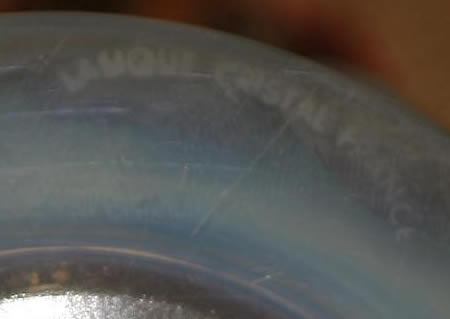
The hallmark of the post-war crystal reproduction Bacchantes is that the bottom of the vase is flat and does not have the concave (indented) center section to the underside of the base that is found on original Rene Lalique Bacchantes. This is the key point to look out for. R. Lalique collectors should avoid any flat bottom Bacchantes Vase no matter what the signature says.
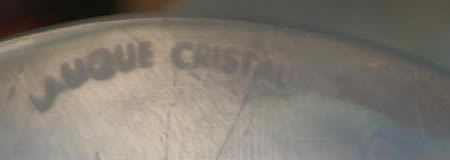
But the next point: It is possible to alter a flat bottom vase and polish out a concave center section to the underside of the base. It’s a lot of work and will involve some expense and some risk, but the stakes are high, with the original R Lalique vases being worth much more than the post-war crystal reproductions. At the time this article was originally written it said: “We have not seen such a vase, but technically it is possible and just something to keep in mind.” However, we have seen several such vases in the years since this article originally appeared. We have seen modern colored Bacchantes that were altered by experienced glass workers from the Alsace region of France, including making the bottoms concave and adding forged pre-war signatures. The perpetrators were apparently caught but not until after some number of forged Bacchantes had made their way to the market. Those expertly altered and forged vases are almost certainly still out there in various collections and will appear in the future.
And the fact that experienced glass workers knew to alter the bottoms to make them concave to be convincing as pre-war? That kind of proves our point.
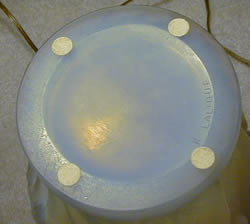 Once you are past the flat bottom (see photo on left for an authentic Rene Lalique Glass Bacchantes Vase concave underside), all the regular general rules of evaluation apply. Three sample criteria to keep in mind are: Once you are past the flat bottom (see photo on left for an authentic Rene Lalique Glass Bacchantes Vase concave underside), all the regular general rules of evaluation apply. Three sample criteria to keep in mind are:
1. Crystal is heavier than glass, and it feels different. Your best defense is to have handled thousands of pieces of R Lalique so you might know just by handling if you have an original glass version, or a later crystal reproduction.
2. An equally good defense, especially with the amounts of money involved, is to hire an independent reputable Rene Lalique Expert Consultant to evaluate or locate potential purchases. Getting independent advice from a reputable source flows nicely to our third sample criteria:
3. Deal with an honest and competent seller!!! Dealing with an honest and competent seller is not the end of all potential problems, but if you have a choice, an honest and competent seller is the way to go. Not starting out every purchase having to think about how the seller is trying to get one over on you* does provide some assurance and makes the collecting experience a lot more enjoyable. Of course when buying online or making one-off purchases thru similar methods, you may not know much about the seller and we highly recommend in any event getting as educated as you can and spending your time focusing on the item you plan to purchase.
But if you know your seller or dealer makes a living selling R Lalique, then you definitely want to be dealing with someone that is both honest and competent. And when you combine dealing with an honest and competent seller with getting independent expert advice from a reputable consultant, you have drastically reduced the chance to have regrets and you are much more likely to obtain high quality examples at fair prices and build a great collection in a much more pleasant way.
And if you want to know more about Lalique Crystal, the crystal items made after the death of Rene Lalique, a good starting point is the Lalique Crystal section of the Rene Lalique Biography at RLalique.com. There you’ll find links to all the information on RLalique.com about Lalique Crystal, and also a link to the website of the modern crystal maker Lalique S.A.
*to get one over on you – to try and slip something by you, to dupe, trick, fool, or deceive you. On the other side of the pond there are similar expressions with similar meanings in use in different parts of the country – “get over on you”, “to have you off”, or “to have you on” are three examples.
**strong suit – something at which one excels
Tags: Lalique Crystal - Cristal Lalique Company, R Lalique - Rene Lalique Authentication, R Lalique and Rene Lalique Fakes-Copies-Frauds, R Lalique Vases and Rene Lalique Vases, R Lalique Videos and Rene Lalique Videos
Posted in Articles of Interest to Collectors, R Lalique - Rene Lalique Authentication Identification | No Comments »
Rene Lalique Glass Panel Doors: Lalique’s Doors at 40 Cours la Reine – A Lalique Architectural Landmark
February 19th, 2010
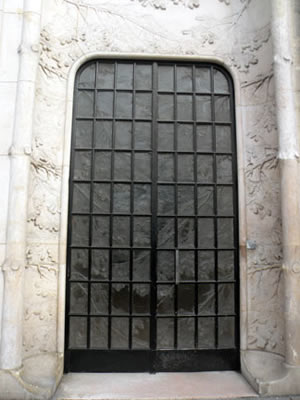 Rene Lalique moved in 1902 to a new residence and workshop at 40 Cours la Reine in Paris. The building was a renovation totaling five floors. The first two floors were show and retail space for Lalique’s expanding business. There was also Lalique’s workshop and Lalique’s residence above. Rene Lalique moved in 1902 to a new residence and workshop at 40 Cours la Reine in Paris. The building was a renovation totaling five floors. The first two floors were show and retail space for Lalique’s expanding business. There was also Lalique’s workshop and Lalique’s residence above.
It was here, that Lalique installed what might be his first and most important architectural statement; the famous Lalique glass panel doors. The doors consisted of glass panels set in a metal frame.
These doors contain a design of pinecones and branches with each panel being a different part of the picture. The relief glass design of the doors continues from the glass panels onto the exterior of the building. It’s also echoed in the railings that rim the windows of the residence!
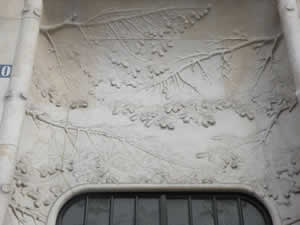 Lalique died at the age of 85 in this same house 43 years later as World War II was coming to and end. Lalique died at the age of 85 in this same house 43 years later as World War II was coming to and end.
Over a century later, the doors remain a quiet yet iconic reminder of the creativity, foresight, and design talent of Rene Lalique. And as Nicholas Dawes notes in his standard reference work “Lalique Glass”, this single creative element incorporated into the exterior decor of his own shop and residence, may have been responsible for many future architectural commissions as potential clients came to the shop and experienced the wonder of the great glass panel doors.
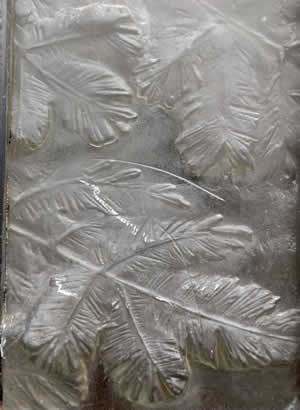 If you are in Paris though, you may have trouble finding the doors at 40 Cours la Reine. Why? Because the street has been renamed to 40 Cour d’Albert! If you are in Paris though, you may have trouble finding the doors at 40 Cours la Reine. Why? Because the street has been renamed to 40 Cour d’Albert!
But worry not if you cannot find or cannot go!
We have found a good-humored guy from the east coast, Richard Nahem, who now lives in Paris and who loves to take photos. Richard has taken some great detailed pictures of the former Lalique residence including the famous Lalique Glass doors. So we thought it would be great to share this bit of Lalique architectural history with you as shown through those photos
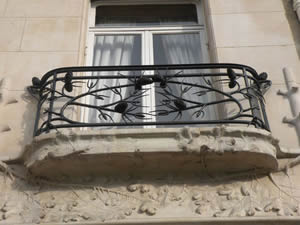 And don’t forget, you can find links to all resources related to Rene Lalique Architecture at RLalique.com in the Rene Lalique Architecture Section of the Lalique Biography. And don’t forget, you can find links to all resources related to Rene Lalique Architecture at RLalique.com in the Rene Lalique Architecture Section of the Lalique Biography.
By the way, Richard runs a very entertaining and informative blog about life in Paris, aptly named eyepreferparis.com! Of course, if this writer were penning a location touting blog, it would likely be named EyePreferHangingOutAtWorldHeadquarters.com!
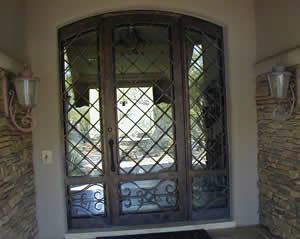 And lest you be left in wonder, yes, World Headquarters is not without its own great glass and metal work door. Notice all the similarities? The great Lalique doors have glass and our door has glass. The great Lalique doors have metal and our door has metal. The Lalique doors open and close and our door opens and closes. Pretty similar right? It’s almost freaky the number of things the World Headquarter door has in common with the Lalique doors. Too bad it can’t hold a candle to* the work of the great Rene Lalique 🙂 Hmmmmm….. And lest you be left in wonder, yes, World Headquarters is not without its own great glass and metal work door. Notice all the similarities? The great Lalique doors have glass and our door has glass. The great Lalique doors have metal and our door has metal. The Lalique doors open and close and our door opens and closes. Pretty similar right? It’s almost freaky the number of things the World Headquarter door has in common with the Lalique doors. Too bad it can’t hold a candle to* the work of the great Rene Lalique 🙂 Hmmmmm…..
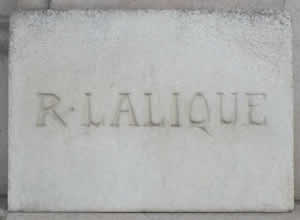 *”Can’t hold a candle to” is an expression from the days before electric lights. When a person had to do some work in the dark, it might require a helper to hold a candle to illuminate the work area. Simple job, holding the candle. Of course, if your skill level or attention level or work ethic was so low that you could not properly perform the task of holding the candle it would put you in a negative light (no pun intended on the light thing). Anyway, can’t hold a candle to whatever, became a phrase to denote low talent or low worthiness by comparison to something else. *”Can’t hold a candle to” is an expression from the days before electric lights. When a person had to do some work in the dark, it might require a helper to hold a candle to illuminate the work area. Simple job, holding the candle. Of course, if your skill level or attention level or work ethic was so low that you could not properly perform the task of holding the candle it would put you in a negative light (no pun intended on the light thing). Anyway, can’t hold a candle to whatever, became a phrase to denote low talent or low worthiness by comparison to something else.
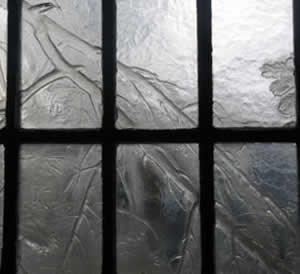 For example, there is no website in the world about Rene Lalique and his works that can hold a candle to RLalique.com! Don’t know how we thought up this great example, it just popped in our heads! For example, there is no website in the world about Rene Lalique and his works that can hold a candle to RLalique.com! Don’t know how we thought up this great example, it just popped in our heads!
Tags: R Lalique Architecture - Rene Lalique Architecture, Rene Lalique Biography, Rene Lalique History and R Lalique History
Posted in Articles of Interest to Collectors, R Lalique and Rene Lalique History | No Comments »
|

 But the story is in the models. Looking at paperweights for example, ignoring crossover mascot/paperweight models, the paperweights comprise all the known commercial examples except a single religious theme 1943 paperweight. That means the incredibly rare Crab, Lobster, and both Sardine Paperweights are offered!
But the story is in the models. Looking at paperweights for example, ignoring crossover mascot/paperweight models, the paperweights comprise all the known commercial examples except a single religious theme 1943 paperweight. That means the incredibly rare Crab, Lobster, and both Sardine Paperweights are offered! And the provenance on many of the other pieces is notable. We’ll give just 2 examples to make the point. The single Cire Perdue traces to the milestone December 1995 Kagan Sale in New York City. And the great Mouche Seal traces to the December 2005 sale in Paris of items from the estate of Marie Claude Lalique.
And the provenance on many of the other pieces is notable. We’ll give just 2 examples to make the point. The single Cire Perdue traces to the milestone December 1995 Kagan Sale in New York City. And the great Mouche Seal traces to the December 2005 sale in Paris of items from the estate of Marie Claude Lalique.


 The newly renamed Corning Flint Glass Works was up and operating in 1868, but by 1870 had gone broke. Fortuitously Houghton’s two sons were able to get the business back (sans Houghton Sr.), and succeeded in getting the company on a firmer financial footing, thanks to a small number of products such as colored signal lights for railroads!*
The newly renamed Corning Flint Glass Works was up and operating in 1868, but by 1870 had gone broke. Fortuitously Houghton’s two sons were able to get the business back (sans Houghton Sr.), and succeeded in getting the company on a firmer financial footing, thanks to a small number of products such as colored signal lights for railroads!* Corning has high tech, high talent, and very low turnover. They are so heavy on innovation and invention, you get the feeling that when a company needs a glass problem solved and approaches Corning, that more often than not a Corning guy in the room says, “We’ve got something on the shelf (from 1, 2, 10, or 20 years ago) we can make work for that.”
Corning has high tech, high talent, and very low turnover. They are so heavy on innovation and invention, you get the feeling that when a company needs a glass problem solved and approaches Corning, that more often than not a Corning guy in the room says, “We’ve got something on the shelf (from 1, 2, 10, or 20 years ago) we can make work for that.” The museum is an independent and not-for-profit organization whose mission it to tell about and keep alive the history and the art of glass. In addition to being an operating museum visited by something like 400,000 people per year, it also holds seminars, classes, demonstrations, workshops, and lectures. It has everything from glassmaking to glass breaking demonstrations, and museum visitors can literally make their own glass as part of their experience at the Corning. On top of all that, the museum is active in both scientific research and publishing on a wide variety of glass related topics.
The museum is an independent and not-for-profit organization whose mission it to tell about and keep alive the history and the art of glass. In addition to being an operating museum visited by something like 400,000 people per year, it also holds seminars, classes, demonstrations, workshops, and lectures. It has everything from glassmaking to glass breaking demonstrations, and museum visitors can literally make their own glass as part of their experience at the Corning. On top of all that, the museum is active in both scientific research and publishing on a wide variety of glass related topics. Also part of the museum is the Rakow research library (named after significant benefactors of the museum), the leading research library on glass anywhere in the world. The library has an extensive collection of original period materials on all aspects of glass and glassmaking. Of note is that the collection includes some great original materials related to Rene Lalique (yes, we’re getting to that guy soon:) some of which previously resided right here at World Headquarters! Of course, these are but a small part of the over 2000 documents relating to Lalique’s glass production housed at the Rakow.
Also part of the museum is the Rakow research library (named after significant benefactors of the museum), the leading research library on glass anywhere in the world. The library has an extensive collection of original period materials on all aspects of glass and glassmaking. Of note is that the collection includes some great original materials related to Rene Lalique (yes, we’re getting to that guy soon:) some of which previously resided right here at World Headquarters! Of course, these are but a small part of the over 2000 documents relating to Lalique’s glass production housed at the Rakow. But in 2011, Stanford and Elaine Steppa, New Jersey residents with a longtime involvement in the works of the great Lalique, donated about 400 items to the museum. Most of the items were commercial production pieces, which by their numbers sampled the largest part of the gamut, in time and types, of Lalique’s commercial works. And there were also a few amazing rare unique and nearly unique items as well.
But in 2011, Stanford and Elaine Steppa, New Jersey residents with a longtime involvement in the works of the great Lalique, donated about 400 items to the museum. Most of the items were commercial production pieces, which by their numbers sampled the largest part of the gamut, in time and types, of Lalique’s commercial works. And there were also a few amazing rare unique and nearly unique items as well.
 Our takeaway*** from an in-depth interview with the exhibition curator Kelley Jo Elliot**** can be boiled to down to one overriding message. The purpose of the exhibition is to tell the story. From the Cire Perdue Vase, to tell how he did it and how it came to be. From the 1893 exhibition medal, to tell what his goals were, what was important to him, and how he was trying to achieve his aims. From the round green glass invitation medallion, to show his technique and his touch. And from the iconic commercial R. Lalique items such as the Serpent Vase, the Tourbillons Vase, or the Suzanne Statue, to be able to explain in the context of Lalique, his world and his history, how these wonderful art glass pieces were developed.
Our takeaway*** from an in-depth interview with the exhibition curator Kelley Jo Elliot**** can be boiled to down to one overriding message. The purpose of the exhibition is to tell the story. From the Cire Perdue Vase, to tell how he did it and how it came to be. From the 1893 exhibition medal, to tell what his goals were, what was important to him, and how he was trying to achieve his aims. From the round green glass invitation medallion, to show his technique and his touch. And from the iconic commercial R. Lalique items such as the Serpent Vase, the Tourbillons Vase, or the Suzanne Statue, to be able to explain in the context of Lalique, his world and his history, how these wonderful art glass pieces were developed.


 The plant is the stuff of legends in Germany, where one legend has it that when God named all the plants, a small genus cried out, Forget-me-not, O Lord! And God replied by naming the plant just that. A bit closer to our time, in the 1400’s in Germany, it was commonly held that if someone wore the flower from this plant, their lovers would not forget them! In 1926 it was adopted as an emblem by the German Freemasons as a message not to forget the needy (Das Vergissmeinnicht), and was likewise adopted by other charitable groups in Germany and elsewhere. It’s also rumored that the Freemasons used it during the Nazi era in Germany in substitution for their typical square and compass symbol as a secret outward means of identification when the Nazis began confiscating Freemason property.
The plant is the stuff of legends in Germany, where one legend has it that when God named all the plants, a small genus cried out, Forget-me-not, O Lord! And God replied by naming the plant just that. A bit closer to our time, in the 1400’s in Germany, it was commonly held that if someone wore the flower from this plant, their lovers would not forget them! In 1926 it was adopted as an emblem by the German Freemasons as a message not to forget the needy (Das Vergissmeinnicht), and was likewise adopted by other charitable groups in Germany and elsewhere. It’s also rumored that the Freemasons used it during the Nazi era in Germany in substitution for their typical square and compass symbol as a secret outward means of identification when the Nazis began confiscating Freemason property. Thoreau (“the mouse ear forget me not…”) and other writers of the 19th and 20th centuries incorporated it into the classic literature of our upbringing. And in 1928, Rene Lalique adopted it as the design motif for the Garniture he named after that same flowering plant: Myosotis. It’s French for “forget-me-not”!
Thoreau (“the mouse ear forget me not…”) and other writers of the 19th and 20th centuries incorporated it into the classic literature of our upbringing. And in 1928, Rene Lalique adopted it as the design motif for the Garniture he named after that same flowering plant: Myosotis. It’s French for “forget-me-not”! Finally, as with other large nude stoppered pieces such as the vases
Finally, as with other large nude stoppered pieces such as the vases 

 I believe that the item has been in my family for at least 60 years. The bowl itself is 9 cm high and 30 cm diameter (approximately). The faint R Lalique stamp appears in the centre of the base of the bowl.
I believe that the item has been in my family for at least 60 years. The bowl itself is 9 cm high and 30 cm diameter (approximately). The faint R Lalique stamp appears in the centre of the base of the bowl. Because Calypso is bigger (Ondines bowl is 8 inches), it is more often seen converted to a hanging or ceiling fixture.
Because Calypso is bigger (Ondines bowl is 8 inches), it is more often seen converted to a hanging or ceiling fixture. And we didn’t get into the number of hanging cords with the questioner, but it appears from the photos that there are only three, and four would be much more typical for these hanging bowl fixtures from Rene Lalique.
And we didn’t get into the number of hanging cords with the questioner, but it appears from the photos that there are only three, and four would be much more typical for these hanging bowl fixtures from Rene Lalique. And about alterations, he drilled holes in many bowls (but not Calypso or Ondines) to attach hanging cords, and marketed them as light shades. He cut bowls in halves and quarters and called them appliques. He affixed seals to small dishes and called them ashtrays. He sold car mascots as paperweights, and re-used parts from some pieces to make others. He even drilled holes into the sides of vases for running electric cords to convert them to lamps. Heaven Forfend!
And about alterations, he drilled holes in many bowls (but not Calypso or Ondines) to attach hanging cords, and marketed them as light shades. He cut bowls in halves and quarters and called them appliques. He affixed seals to small dishes and called them ashtrays. He sold car mascots as paperweights, and re-used parts from some pieces to make others. He even drilled holes into the sides of vases for running electric cords to convert them to lamps. Heaven Forfend!
 In Arthurian legend, Tristan (as shown here in an Arthur James Draper depiction) is the 12th century** Cornish Knight of the Round Table having a scandalous relationship with Iseult, the wife of the King. Incidentally, this tale of complicated involvement was kept alive in story form in France by hundreds of poets over the following centuries.
In Arthurian legend, Tristan (as shown here in an Arthur James Draper depiction) is the 12th century** Cornish Knight of the Round Table having a scandalous relationship with Iseult, the wife of the King. Incidentally, this tale of complicated involvement was kept alive in story form in France by hundreds of poets over the following centuries.  But before the 1900’s, when the Brits got a hold of the islands (formerly annexing them in 1816 just after the first permanent settler from of all places Salem Massachusetts landed in 1810), they dissed Tristao and changed the name to Tristan da Cunha, a name that has been shortened colloquially to Tristan. Note that the Queen of England still reigns over Tristan and it’s 250 or so inhabitants.
But before the 1900’s, when the Brits got a hold of the islands (formerly annexing them in 1816 just after the first permanent settler from of all places Salem Massachusetts landed in 1810), they dissed Tristao and changed the name to Tristan da Cunha, a name that has been shortened colloquially to Tristan. Note that the Queen of England still reigns over Tristan and it’s 250 or so inhabitants. A little closer to our own time, after the great movie “Legends of the Fall” was released in 1994, Tristan, the name of the character in the movie played by Brad Pitt, became (and remains to this day) one of the top 100 baby boy names in the United States! Sadly, the author of Legends Of The Fall, Jim Harrison, passed away in Patagonia Arizona March 26th, 2016, not far from World Headquarters. He had moved from rural Michigan to Montana (the setting for the story), and Arizona. In each place he wrote in solitude, surrounded by natural beauty. And while he stood on the shoulders of Thoreau, his writing was uniquely his own. He was regarded by many as the greatest living American fiction writer.
A little closer to our own time, after the great movie “Legends of the Fall” was released in 1994, Tristan, the name of the character in the movie played by Brad Pitt, became (and remains to this day) one of the top 100 baby boy names in the United States! Sadly, the author of Legends Of The Fall, Jim Harrison, passed away in Patagonia Arizona March 26th, 2016, not far from World Headquarters. He had moved from rural Michigan to Montana (the setting for the story), and Arizona. In each place he wrote in solitude, surrounded by natural beauty. And while he stood on the shoulders of Thoreau, his writing was uniquely his own. He was regarded by many as the greatest living American fiction writer. That price makes the blue
That price makes the blue 
 And this includes parts made from actual R. Lalique glass. So for example, if a dealer gets a glass guy to make a new stopper out of the thick base of a broken vase; to literally hand carve the thing from authentic Rene Lalique glass to the point where virtually no one would know the difference, this is not what this article is about.
And this includes parts made from actual R. Lalique glass. So for example, if a dealer gets a glass guy to make a new stopper out of the thick base of a broken vase; to literally hand carve the thing from authentic Rene Lalique glass to the point where virtually no one would know the difference, this is not what this article is about. Sometimes a complete decanter, perfume bottle, or box may come up for sale, but because of the model, or damage to one of the pieces, or just luck of timing, it may go for a low enough price that it pays to buy the whole thing just to get the undamaged part you want (and hope it fits of course).
Sometimes a complete decanter, perfume bottle, or box may come up for sale, but because of the model, or damage to one of the pieces, or just luck of timing, it may go for a low enough price that it pays to buy the whole thing just to get the undamaged part you want (and hope it fits of course).

 The request (again, ID’s hidden and minor grammar corrections to make everyone look better):
The request (again, ID’s hidden and minor grammar corrections to make everyone look better): And the last we heard:
And the last we heard: On the other hand, while the South was engaged in a vast agricultural based commercial and wealth expansion because of the cotton gin, his push to manufacture with interchangeable parts strengthened the North’s existing industrial advantage over the South, and thereby contributed significantly to the North’s victory in the Civil War.
On the other hand, while the South was engaged in a vast agricultural based commercial and wealth expansion because of the cotton gin, his push to manufacture with interchangeable parts strengthened the North’s existing industrial advantage over the South, and thereby contributed significantly to the North’s victory in the Civil War.
 A representation that word by word could be claimed to be true. We can see you at the used car dealer now, when the salesman tells you the car you are looking at has no dents, no scratches, and no paint chips of any kind! The only problem is that the front bumper, both front fenders, and the hood are missing. But not a scratch, not a dent, and no paint chips anywhere. Hmmmmmmmm.
A representation that word by word could be claimed to be true. We can see you at the used car dealer now, when the salesman tells you the car you are looking at has no dents, no scratches, and no paint chips of any kind! The only problem is that the front bumper, both front fenders, and the hood are missing. But not a scratch, not a dent, and no paint chips anywhere. Hmmmmmmmm.
 The third and final listing we want to bring to your attention has met the difficult task of hitting a trifecta** of issues in just one listing. A trifecta within a trifecta when considering the entire situation really.
The third and final listing we want to bring to your attention has met the difficult task of hitting a trifecta** of issues in just one listing. A trifecta within a trifecta when considering the entire situation really. Both the
Both the  The problem that has been created is that the undecorated glass body of the vase can be duplicated! Yes, it is not all that difficult to make a credible copy of the plain glass body, drill holes in it, and attach a set of handles removed from a damaged Cluny or Senlis. Especially with the current pricing in the market of these vases (a
The problem that has been created is that the undecorated glass body of the vase can be duplicated! Yes, it is not all that difficult to make a credible copy of the plain glass body, drill holes in it, and attach a set of handles removed from a damaged Cluny or Senlis. Especially with the current pricing in the market of these vases (a  So, is there anything wrong with “fixing”, some would say “saving” a damaged vase in this fashion? Of course not, so long as you make mention of it when you sell it!
So, is there anything wrong with “fixing”, some would say “saving” a damaged vase in this fashion? Of course not, so long as you make mention of it when you sell it!

 She left $300,000 in her will to her adopted home town “… for the purchase of necessary ground in Kansas City, Missouri, and the creation of a building to be maintained and used as a Museum of Fine Arts for the use and benefit of the public.”
She left $300,000 in her will to her adopted home town “… for the purchase of necessary ground in Kansas City, Missouri, and the creation of a building to be maintained and used as a Museum of Fine Arts for the use and benefit of the public.” Walters would die in 1931, leaving his palazzo like art house and contents to the City of Baltimore. It remains today, over 75 years after its opening in 1934, as
Walters would die in 1931, leaving his palazzo like art house and contents to the City of Baltimore. It remains today, over 75 years after its opening in 1934, as  These Atkins and Nelson bequests were unrelated and each estate had its own plans. So it would be some time before events would take their course and these two different bequests would join purpose and coalesce into something tangible for an even greater public good. But coalesce they did, and with trustees for the schoolteacher, the publisher, and the local government working together, in December 1933, at the height of the great depression, on the grounds of Nelson’s former mansion, the new museum was opened to the public. The cost was a striking 2.75 million dollars.
These Atkins and Nelson bequests were unrelated and each estate had its own plans. So it would be some time before events would take their course and these two different bequests would join purpose and coalesce into something tangible for an even greater public good. But coalesce they did, and with trustees for the schoolteacher, the publisher, and the local government working together, in December 1933, at the height of the great depression, on the grounds of Nelson’s former mansion, the new museum was opened to the public. The cost was a striking 2.75 million dollars. Coincidently, the museum architecture was modeled after the classic design of the Cleveland Museum of Art, which recently put on its own
Coincidently, the museum architecture was modeled after the classic design of the Cleveland Museum of Art, which recently put on its own  And it is at the Nelson-Atkins Museum Of Art in Kansas City Missouri, born of the generous mid-western philanthropic and charitable mindset that is a hallmark of the American character, as part of their amazing and creative exhibition “Inventing the Modern World: Decorative Arts at the World’s Fairs, 1851–1939” that our story comes together.
And it is at the Nelson-Atkins Museum Of Art in Kansas City Missouri, born of the generous mid-western philanthropic and charitable mindset that is a hallmark of the American character, as part of their amazing and creative exhibition “Inventing the Modern World: Decorative Arts at the World’s Fairs, 1851–1939” that our story comes together. It’s only natural that among the makers who would not shy away, but would savor the chance to bring the a-game*** to such a gathering, would be the great Rene Lalique. Be it Paris in 1900 or 1925, St. Louis in 1904, or anywhere else on the globe that the leading artistic endeavors of the day would meet and be compared side by side, Rene Lalique was an anxious participant. And it was that country mile from the schoolteacher and the publisher, a perfect place for the great Lalique to show his goods half a world away from home, that Henry Walters bought, retained, and donated for the public delectation, two of the three pieces of phenomenal Lalique Jewelry that have once again made the trip back to where they first met the American public eye, in Missouri.
It’s only natural that among the makers who would not shy away, but would savor the chance to bring the a-game*** to such a gathering, would be the great Rene Lalique. Be it Paris in 1900 or 1925, St. Louis in 1904, or anywhere else on the globe that the leading artistic endeavors of the day would meet and be compared side by side, Rene Lalique was an anxious participant. And it was that country mile from the schoolteacher and the publisher, a perfect place for the great Lalique to show his goods half a world away from home, that Henry Walters bought, retained, and donated for the public delectation, two of the three pieces of phenomenal Lalique Jewelry that have once again made the trip back to where they first met the American public eye, in Missouri.
 In addition to the wonderful Pansy Brooch and Grape Necklace from The Walters, is the amazing Wasps Stickpin exhibited at the Exposition Universelle de Paris in 1900. This stickpin has been lent by the
In addition to the wonderful Pansy Brooch and Grape Necklace from The Walters, is the amazing Wasps Stickpin exhibited at the Exposition Universelle de Paris in 1900. This stickpin has been lent by the  You can also visit the
You can also visit the  The new edition has arrived just in time for RLalique collectors and Rene Lalique enthusiasts needing this great reference work. The last edition was published 7 years ago in 2004. It has been sold out for several years. Actual sale prices have risen north of $750 (sometimes well north) in our
The new edition has arrived just in time for RLalique collectors and Rene Lalique enthusiasts needing this great reference work. The last edition was published 7 years ago in 2004. It has been sold out for several years. Actual sale prices have risen north of $750 (sometimes well north) in our  The total price still represents a major drop from recent sales of older editions, and while some sellers are still hoping against hope (there is one listing currently on Ebay for a 2004 Edition for $1500), others have quickly brought their prices down below the cost of the new book to reflect the new reality.
The total price still represents a major drop from recent sales of older editions, and while some sellers are still hoping against hope (there is one listing currently on Ebay for a 2004 Edition for $1500), others have quickly brought their prices down below the cost of the new book to reflect the new reality. In 1860, the year before the American Civil War started, 10 year old Jesse Boot of Nottingham England began helping his mother run the family medicine shop when his father John died. By age 13 he left school to concentrate on his work in the shop. In the ensuing decades, Jesse would turn the single medicine shop into the major national chain Boots the Chemists. 60 years later in 1920, he sold control of the “Chemists to the Nation” to an American company. Jesse died on the Channel Island of Jersey 11 years later in 1931.
In 1860, the year before the American Civil War started, 10 year old Jesse Boot of Nottingham England began helping his mother run the family medicine shop when his father John died. By age 13 he left school to concentrate on his work in the shop. In the ensuing decades, Jesse would turn the single medicine shop into the major national chain Boots the Chemists. 60 years later in 1920, he sold control of the “Chemists to the Nation” to an American company. Jesse died on the Channel Island of Jersey 11 years later in 1931. Boot was also a philanthropist, especially in Nottingham and in Jersey. For one of many examples, he donated the land for what is now the University of Nottingham, which opened in 1928, where the Jesse Boot Chair in Chemistry was named in his honor.
Boot was also a philanthropist, especially in Nottingham and in Jersey. For one of many examples, he donated the land for what is now the University of Nottingham, which opened in 1928, where the Jesse Boot Chair in Chemistry was named in his honor.
 An organization named The Friends of the Glass Church has been set-up under the auspices of the Lieutenant Governor of Jersey, Lieutenant General Andrew Ridgway, to raise funds for the renovations. They have already raised approximately £140,000 toward the project. Updating of the roof was finished in 2010. Also the States of Jersey has approved a matching funds grant of £125,000. Phase two, which is the refurbishment of the bell tower, bells, and some asbestos removal, should be completed in early October, at which time the church will re-open.
An organization named The Friends of the Glass Church has been set-up under the auspices of the Lieutenant Governor of Jersey, Lieutenant General Andrew Ridgway, to raise funds for the renovations. They have already raised approximately £140,000 toward the project. Updating of the roof was finished in 2010. Also the States of Jersey has approved a matching funds grant of £125,000. Phase two, which is the refurbishment of the bell tower, bells, and some asbestos removal, should be completed in early October, at which time the church will re-open. St. Matthew’s home, the island of Jersey has a rich history owing to its location between France and England. It has a population of around 100,000, and both French and English are spoken there. Jersey is a separate possession of the crown; it’s a dependency and not part of the United Kingdom. It even has its own currency, though several other currencies also circulate on the island. It’s a crossroads of cultures and activities.
St. Matthew’s home, the island of Jersey has a rich history owing to its location between France and England. It has a population of around 100,000, and both French and English are spoken there. Jersey is a separate possession of the crown; it’s a dependency and not part of the United Kingdom. It even has its own currency, though several other currencies also circulate on the island. It’s a crossroads of cultures and activities. Rene Lalique pieces show many different authentic R. Lalique signatures and we get regular inquiries asking where R. Lalique owners or collectors can go to see samples of actual R. Lalique signatures. In response, we’ve developed a page where readers can review the different signatures found on genuine pieces of R. Lalique. This new page showing how R. Lalique pieces were signed can coincidentally be found at this link:
Rene Lalique pieces show many different authentic R. Lalique signatures and we get regular inquiries asking where R. Lalique owners or collectors can go to see samples of actual R. Lalique signatures. In response, we’ve developed a page where readers can review the different signatures found on genuine pieces of R. Lalique. This new page showing how R. Lalique pieces were signed can coincidentally be found at this link:  1. Is every piece of R. Lalique signed?
1. Is every piece of R. Lalique signed?
 No, not all signatures or marks contain the phrase “R. Lalique”. Some exceptions would be jewelry with metal backing is many times stamped LALIQUE in the metal, and may or may not be signed on the glass.
No, not all signatures or marks contain the phrase “R. Lalique”. Some exceptions would be jewelry with metal backing is many times stamped LALIQUE in the metal, and may or may not be signed on the glass. There are 2 different VDA molded marks, one with FRANCE molded under it and one without FRANCE. VDA stands for Verrerie D’Alsace which is French for Alsatian Glassware. There’s also the Masque mark shown here. These 3 marks do not say R. Lalique. There are also some pieces signed just Lalique in the glass, either inscribed or in the mold. And there are a small number of items with just R L in the mold. Those are mainly (but not always) perfume bottles with small bases. So while most of what appears is signed R Lalique in one form or another, many pieces are signed differently.
There are 2 different VDA molded marks, one with FRANCE molded under it and one without FRANCE. VDA stands for Verrerie D’Alsace which is French for Alsatian Glassware. There’s also the Masque mark shown here. These 3 marks do not say R. Lalique. There are also some pieces signed just Lalique in the glass, either inscribed or in the mold. And there are a small number of items with just R L in the mold. Those are mainly (but not always) perfume bottles with small bases. So while most of what appears is signed R Lalique in one form or another, many pieces are signed differently.
 A. We sometimes see pieces with molded signatures that are perfectly readable, with a full R. Lalique France engraved or etched signature present as well. On the R. Lalique Signatures Page linked in the first paragraph above, we currently have a couple examples of double signatures at the end of the page, and more may be added over time.
A. We sometimes see pieces with molded signatures that are perfectly readable, with a full R. Lalique France engraved or etched signature present as well. On the R. Lalique Signatures Page linked in the first paragraph above, we currently have a couple examples of double signatures at the end of the page, and more may be added over time. 7. Do all pieces contain the word France in the signature?
7. Do all pieces contain the word France in the signature? If you are looking for examples of faked, forged, and copied R. Lalique signatures, see them on our site at this link:
If you are looking for examples of faked, forged, and copied R. Lalique signatures, see them on our site at this link:  Today, December 1st, 2010, we set the record at RLalique.com for most auctions listed in the Worldwide
Today, December 1st, 2010, we set the record at RLalique.com for most auctions listed in the Worldwide  Here’s the country list for inquiring minds:
Here’s the country list for inquiring minds: More bidders, more auction action for the works of the great Lalique, more exposure in the art world, more publicity, better prices: Everyone benefits!
More bidders, more auction action for the works of the great Lalique, more exposure in the art world, more publicity, better prices: Everyone benefits! The modern Lalique Company has reproduced the Rene Lalique Bacchantes Vase in crystal basically continuously since production of Lalique crystal began after the end of World War II. These crystal reproductions have continued to bring this iconic Rene Lalique design into the homes of tens of thousands of people worldwide even to this day.
The modern Lalique Company has reproduced the Rene Lalique Bacchantes Vase in crystal basically continuously since production of Lalique crystal began after the end of World War II. These crystal reproductions have continued to bring this iconic Rene Lalique design into the homes of tens of thousands of people worldwide even to this day.

 Once you are past the flat bottom (see photo on left for an authentic Rene Lalique Glass Bacchantes Vase concave underside), all the regular general rules of evaluation apply. Three sample criteria to keep in mind are:
Once you are past the flat bottom (see photo on left for an authentic Rene Lalique Glass Bacchantes Vase concave underside), all the regular general rules of evaluation apply. Three sample criteria to keep in mind are: Rene Lalique moved in 1902 to a new residence and workshop at 40 Cours la Reine in Paris. The building was a renovation totaling five floors. The first two floors were show and retail space for Lalique’s expanding business. There was also Lalique’s workshop and Lalique’s residence above.
Rene Lalique moved in 1902 to a new residence and workshop at 40 Cours la Reine in Paris. The building was a renovation totaling five floors. The first two floors were show and retail space for Lalique’s expanding business. There was also Lalique’s workshop and Lalique’s residence above.
 If you are in Paris though, you may have trouble finding the doors at 40 Cours la Reine. Why? Because the street has been renamed to 40 Cour d’Albert!
If you are in Paris though, you may have trouble finding the doors at 40 Cours la Reine. Why? Because the street has been renamed to 40 Cour d’Albert! And don’t forget, you can find links to all resources related to Rene Lalique Architecture at RLalique.com in the
And don’t forget, you can find links to all resources related to Rene Lalique Architecture at RLalique.com in the  And lest you be left in wonder, yes, World Headquarters is not without its own great glass and metal work door. Notice all the similarities? The great Lalique doors have glass and our door has glass. The great Lalique doors have metal and our door has metal. The Lalique doors open and close and our door opens and closes. Pretty similar right? It’s almost freaky the number of things the World Headquarter door has in common with the Lalique doors. Too bad it can’t hold a candle to* the work of the great Rene Lalique 🙂 Hmmmmm…..
And lest you be left in wonder, yes, World Headquarters is not without its own great glass and metal work door. Notice all the similarities? The great Lalique doors have glass and our door has glass. The great Lalique doors have metal and our door has metal. The Lalique doors open and close and our door opens and closes. Pretty similar right? It’s almost freaky the number of things the World Headquarter door has in common with the Lalique doors. Too bad it can’t hold a candle to* the work of the great Rene Lalique 🙂 Hmmmmm….. *”Can’t hold a candle to” is an expression from the days before electric lights. When a person had to do some work in the dark, it might require a helper to hold a candle to illuminate the work area. Simple job, holding the candle. Of course, if your skill level or attention level or work ethic was so low that you could not properly perform the task of holding the candle it would put you in a negative light (no pun intended on the light thing). Anyway, can’t hold a candle to whatever, became a phrase to denote low talent or low worthiness by comparison to something else.
*”Can’t hold a candle to” is an expression from the days before electric lights. When a person had to do some work in the dark, it might require a helper to hold a candle to illuminate the work area. Simple job, holding the candle. Of course, if your skill level or attention level or work ethic was so low that you could not properly perform the task of holding the candle it would put you in a negative light (no pun intended on the light thing). Anyway, can’t hold a candle to whatever, became a phrase to denote low talent or low worthiness by comparison to something else. For example, there is no website in the world about Rene Lalique and his works that can hold a candle to RLalique.com! Don’t know how we thought up this great example, it just popped in our heads!
For example, there is no website in the world about Rene Lalique and his works that can hold a candle to RLalique.com! Don’t know how we thought up this great example, it just popped in our heads!